Keep on the Sunny Side with Stylish Sunglasses
Stylish accessories have long protected elegant gentlemen from the sun. One hundred years ago, hats were the most common item to serve this purpose, but today, sunglasses reign supreme as the preferred method of solar ray avoidance. While sunglasses certainly protect your eyes, they are also an excellent way to add unique personal style to your outfit.
- Keep on the Sunny Side with Stylish Sunglasses
- The Benefits of Wearing Sunglasses
- The History of Sunglasses
- Sunglasses Today
- Men’s Sunglasses FAQ
- How Sunglasses Work
- Lens Options for Sunglasses
- How Sunglasses Should Fit
- Sunglasses Frame Materials
- Sunglasses Frame Construction
- How To Pick The Right Sunglasses For You
- How to Care for Your Sunglasses
- The Do’s and Don’ts of Sunglasses
- Conclusion
But if you want to derive the greatest possible benefit from your sunglasses, you cannot just wear any old pair. There are several rules and conventions that will help you gain the greatest sartorial benefit from your shades, as well as ensure their continued optimal functionality as a sun-protection accessory.
When wearing sunglasses, it can seem like you are destined to feel either one of two ways: like a suave and debonair king of cool, or like a poseur, first-class jerk. With the tips and tricks contained in this guide, we promise, you’ll be entirely the former, and never the latter!
The Benefits of Wearing Sunglasses

Practical Protection
Sunglasses, like many menswear accessories, stemmed from a very practical purpose: protecting your eyes from the intense light radiated by the sun. Not only did this protection reduce or eliminate the damage that the sun’s rays can do to your eyes and eyesight, but it can also improve or even enhance your vision when in conditions of extreme light, allowing you to see well despite the glare. The best sunglasses will still fulfill this important purpose.

Outfit Accessorization
Today, sunglasses are no longer just a simple, practical tool. Decorative aspects and a sense of aesthetics now inform the look and design of contemporary sunglasses. They are, without any doubt, a way to showcase personal style and flair, which is why many men own multiple pairs so as to match the right pair of shades with their outfits, occasion, and mood. Therefore, while you still want to wear sunglasses primarily to protect your eyes, there is no reason that they shouldn’t also help you look fantastic while doing so.
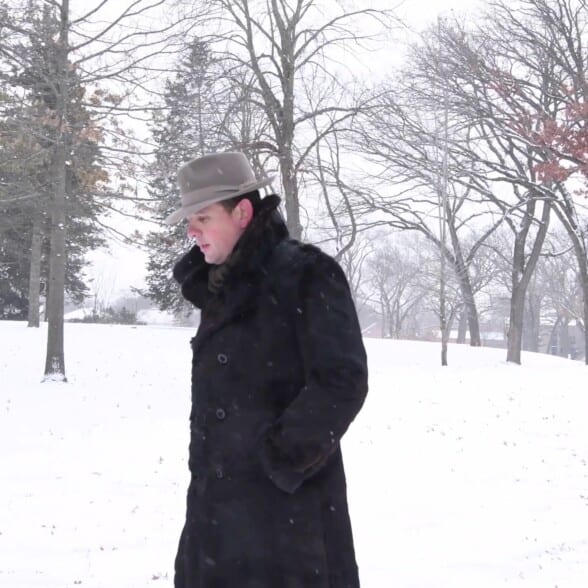
When do you need to wear
Sunglasses?
In most scenarios, eye doctors will recommend wearing protective eyewear such as sunglasses anytime the sun is out, including in mildly overcast conditions: the sun is still radiating light, even when there are clouds in the sky. Similarly, sunglasses should be worn in all seasons. In fact, the glare of the sun off the snow during winter is more likely to adversely affect your vision than the sun during normal summertime conditions.
The History of Sunglasses
Early Historical Eye Protection
From the Inuit Peoples to Roman Emperors
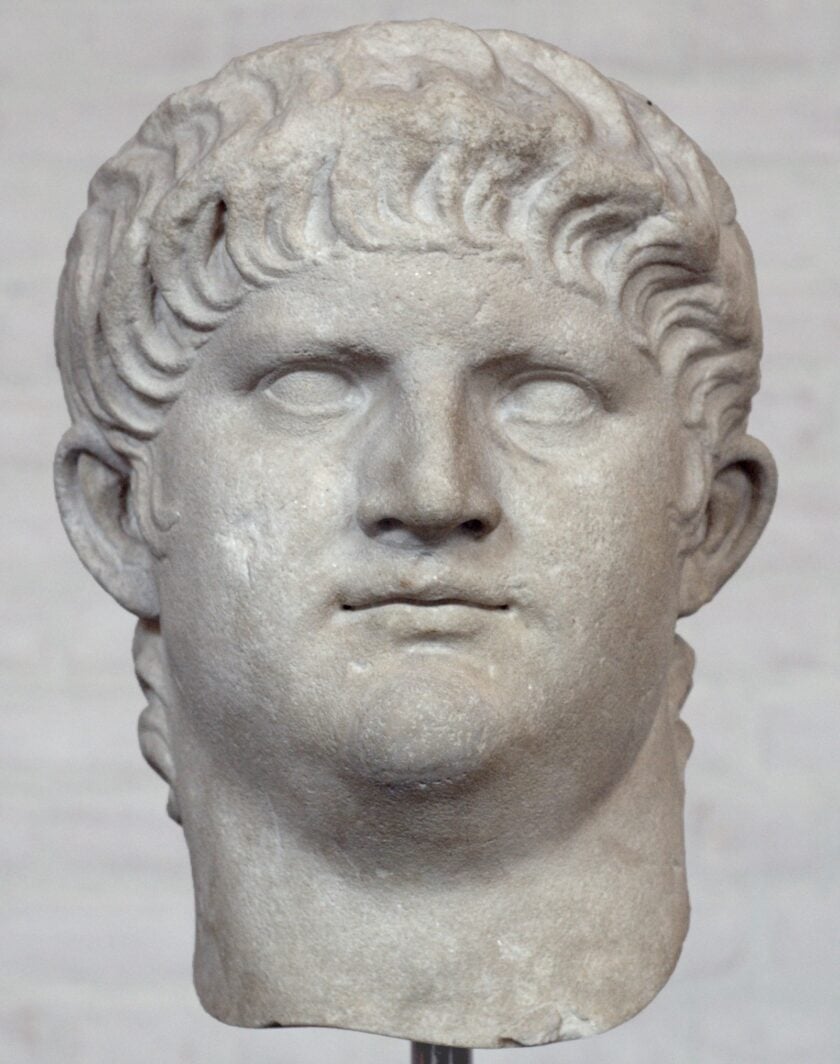
For as long as man has squinted at the blinding sun, the use of sunglasses has been around. Dating as far back as prehistoric times, the Inuit people would cover their eyes with rudimentary, slitted goggles made from walrus ivory that would help to shield their eyes from the harsh rays of the sun.
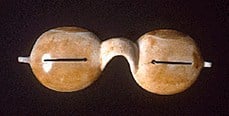
the world’s oldest Snow Goggles?
In order to cut down the glare from snow drifts and reduce snowblindness, the Inuit people made special snow goggles out of walrus or caribou ivory. The thin slits allowed them to see while reducing direct exposure to the sun and its beams.
During Antiquity, transparent minerals would sometimes be held up to the eyes as a primitive form of eye protection – while the crystals would distort the user’s vision, they did cut down glare. According to some historical accounts, the Roman emperor Nero utilized cut emeralds in this way so that he could better see what was happening during gladiatorial matches by reducing the impact of light reflected off of the sand of the area.
“When the surface of the emerald is flat, it reflects the image of objects in the same manner as a mirror. The emperor, Nero, used to view the combats of the gladiators through an emerald.”
From The Natural History of Pliny the Elder
Mineral-Lens Goggles in Imperial China

In Ancient China, smoked quartz crystals were used to a similar effect, reducing the impact of the sun’s glare, albeit with a consummate negative impact on the quality of one’s vision. Goggles made with crystals over the eyes were also worn indoors, although for a very different reason.
The judges in certain of Ancient China’s top courts would wear prescribed sunglasses, not as a method of preventing temporary blindness from the natural elements, but to conceal their faces while questioning witnesses on the stand. Following this historic achievement, government agents working in protective and combat-related roles would also use these shields not only to improve the clarity of their vision in the sun but also to conceal where they were looking.

The Connection between Sunglasses and
Secret Agents
From James Bond to The Men in Black, sunglasses are often associated with secret agents in popular culture. This connection can be partially traced back to Ancient China. Imperial agents were accustomed to wearing goggles with protective mineral lenses both indoors and outdoors: doing so meant that they did not need to wait for their eyes to adjust as much as they would have had they forgone the use of sunglasses as protective eyewear. To this day, the regular wearing of sunglasses is synonymous with bodyguards.
The Development of Modern Sunglasses
Early Experiments with Tinted Lenses
In 1792, the English optician James Ayscough experimented with employing colored lenses in eyeglasses. Spectacles had been known in the West since the Middle Ages, but Ayscough was the first known person to utilize lenses that were not colorless. Ayscough was not, however, attempting to create sunglasses: he believed that blue and green tinted glass could improve the eyesight of visually-impaired people.
The First Modern Sunglasses
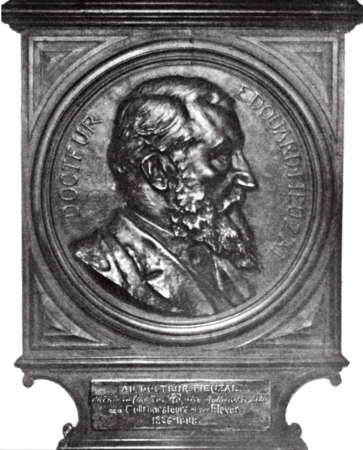
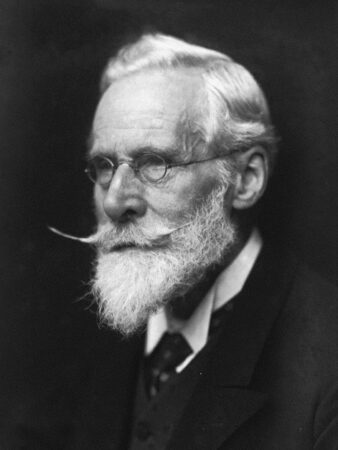
During the 19th century, doctors utilized Ayscough’s experimentation with colored lenses to develop lens colors that helped to protect against the sun: amber and brown tints proved to be the most effective. Originally, these tinted glasses were proscribed to those who suffered from syphilis, a virulent sexually transmitted disease, the symptoms of which include pronounced sensitivity to light.
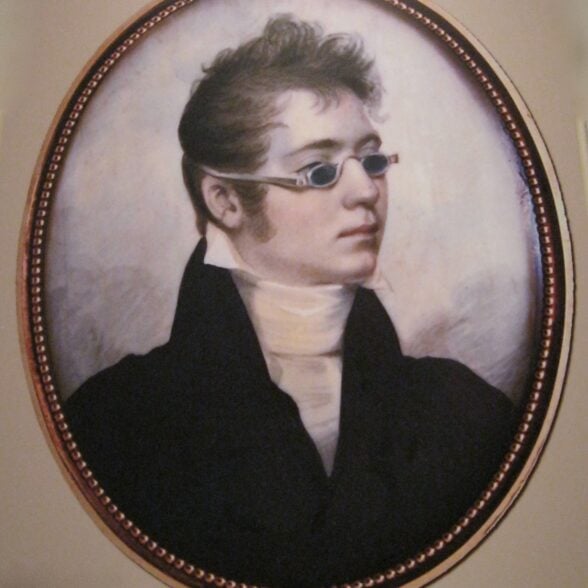
Early Tinted
Lenses
In this 1807 portrait by John Wesley Jarvis, a young man is shown wearing spectacles with dark blue lenses. While these spectacles do somewhat resemble futuristic sunglasses, they are, in fact, intended for vision: early opticians believed that tinted glasses could improve the eyesight of visually-impaired persons.
These amber and brown-tinted spectacles were the first truly modern sunglasses, as they were fully distinct from goggles and closely resembled modern sunglasses in appearance and functionality.
The French scientist Jean-Marie-Théodore Fieuzal discovered in the late 19th century that ultraviolet light, in addition to glare, was responsible for producing strain on the eyes, and in 1913, Sir William Crookes, an English scientist, is credited with developing the first pair of sunglasses designed intentionally to block ultraviolet light fully.
From Medical Device to Daywear Accessory
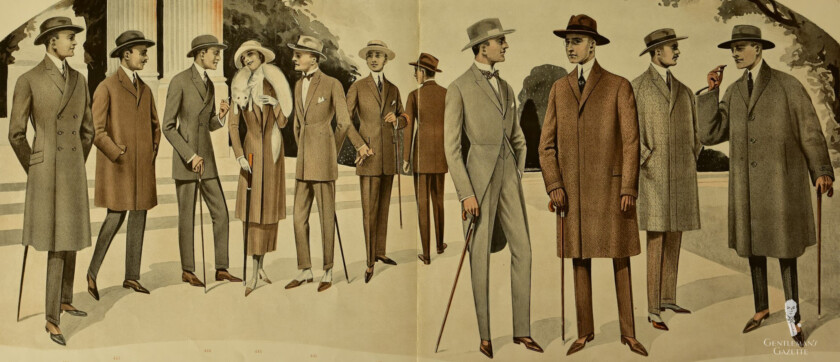
In the late 19th and early 20th centuries, sunglasses were no longer relegated to medical usage, and many people began to wear them casually to reduce eye strain in the sunlight and to improve their vision when outside. Although a still relatively niche accessory, sunglasses had jumped from being purely practical to having a decorative component, as Edwardian sunglasses, like spectacles of the same period, were clearly designed with an eye to aesthetic elements.
20th Century Sunglasses
Sunglasses Become Fashionable Accessories

By the 1920s, sunglasses had become a regular component of daily wear in sunny climates. In particular, Hollywood actors in sun-soaked California began to wear sunglasses regularly to protect their eyes during extended hours of shooting on location in outdoor settings. These sunglasses became a part of the West Coast aesthetics, and actors continued to sport their shades will out-and-about in Los Angeles, San Francisco, and other cities in California.
See all of the 1920s fashion trends!
Buoyed by their popularity with the stars, sunglasses soon began to achieve a widespread following in the masses, first among film buffs and autograph hounds and then within wider segments of the population as fans jockeyed to emulate the looks of their favorite Hollywood celebrities.
Modernization of Sunglasses Manufacturing

Recognizing the increasing demand for sunglasses, Sam Foster, an Austrian immigrant, and his American partner, William Grant, shifted production of their eyeglasses company, which had started in 1919, towards sunglasses. By the late 1920s, their company, Foster-Grant, was producing sunglasses in bulk, which were first hawked to sightseers and pleasure seekers on the boardwalks of Atlantic City. These were some of the first mass-produced sunglasses available in the world, and they proved an immediate hit, servicing an eager audience desperate for the hint of glamour implied by these modish new eyepieces.
By 1938, over 20 million pairs of sunglasses had been sold in the United States alone, and while about a quarter of users were wearing them for expressly medical reasons, everyone else embraced them with a clear emphasis on style. Time magazine, commenting on the phenomenon, declared sunglasses “a favorite affection of women all over the US,” and it was evident that this unique accessory was here to stay.
Sunglasses Go To War

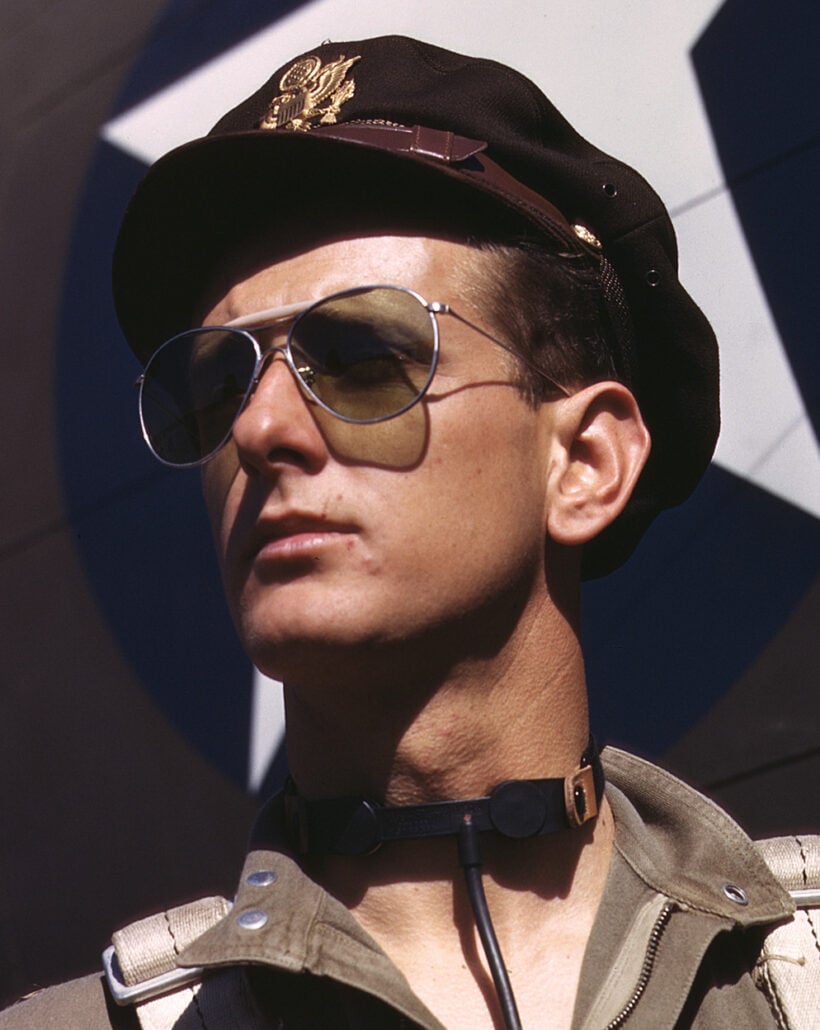
Ironically, as sunglasses gained in popularity as a style accessory, there was no immediate corresponding upwards shift in more practical fields. In aviation, for instance, goggles remained the preferred method of eye protection for most pilots.
This trend changed, however, in 1936, when Russian-American researcher Edwin Herbert Land invented polarized sunglasses. Polarizing filters work by only allowing certain light waves, determined by their polarization, through the lenses to reach the eyes. The admitted polarized light is selected because of its improved clarity, definition, and contrast, meaning that what is seen through the polarized filter lenses appears more clear.
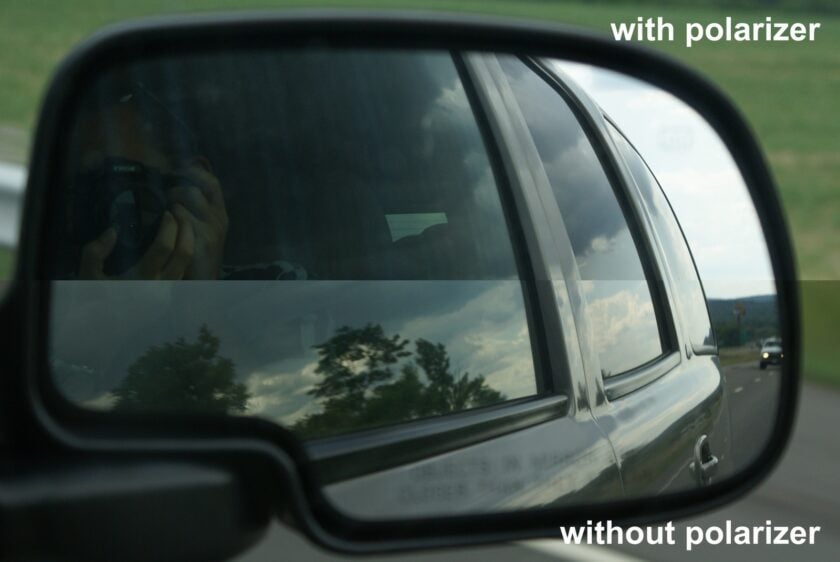
As a result, pilots began to favor polarized sunglasses because they offered superior visibility and glare reduction, and unlike goggles, could be easily taken on and off. Sunglasses became a common accessory worn by members of the armed services and became a ubiquitous sight during World War II.
Sunglasses in the Late 20th Century
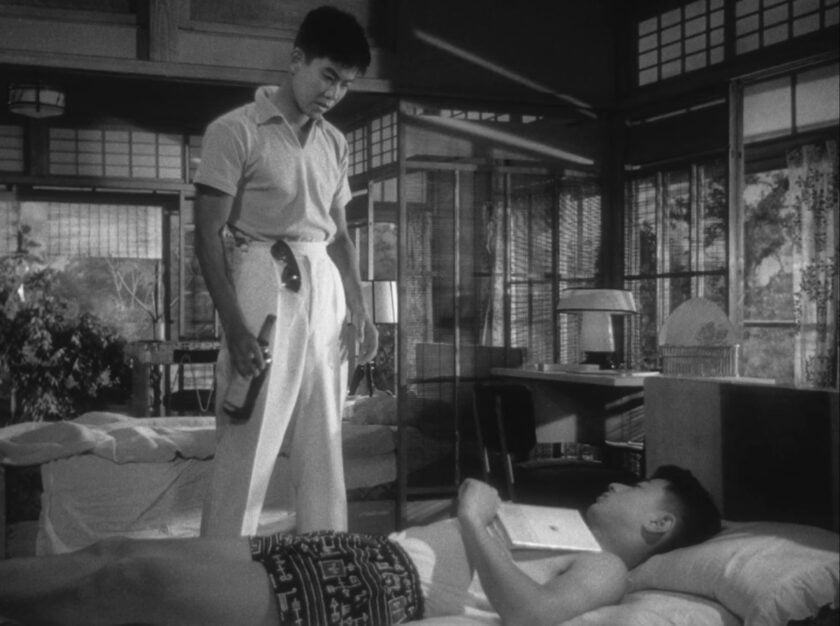
Following World War II, sunglasses continued to grow in popularity as an extremely useful sun protection accessory, especially as hats for men began to fall out of favor. As more companies began to make sunglasses, the results could be of superior or inferior quality, and as brand recognition became a driving force in contemporary fashion, logoed shades proliferated among the offerings of fashion houses, even if they had no reputation for optical excellence.
Celebrities, especially movie stars, remained a driving force behind the popularization of particular types and brands of sunglasses. Alain Delon immortalized a pair of Vuarnet sunglasses in La Piscine (1969), Steve McQueen made Persol iconic internationally, and Tom Cruise took to the skies in a pair of Ray-Bans.
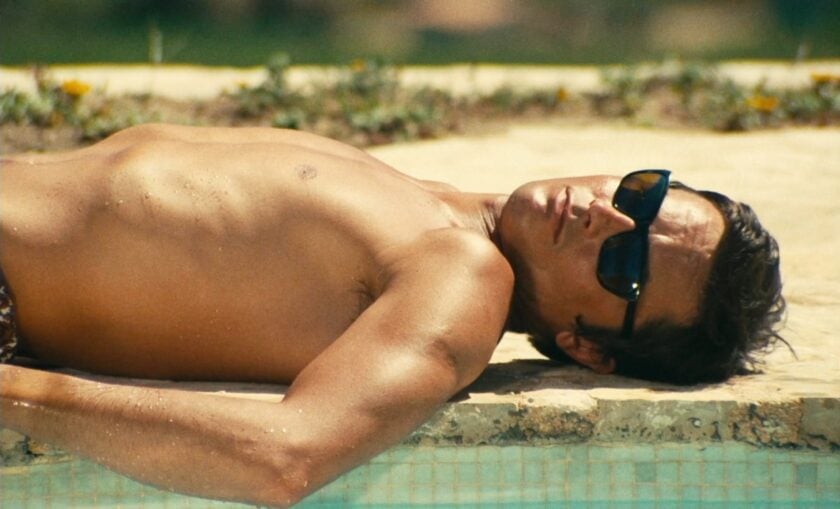
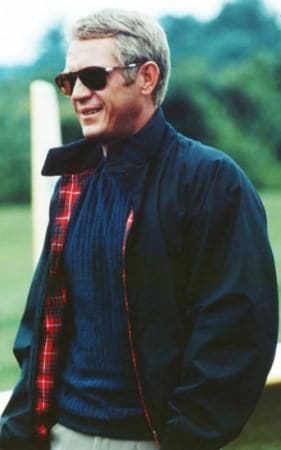

As sunglasses entered the 21st century, it was clear that they would persist as one of the most valued and sought-after accessories, thanks to their utility, ability to impart unexpected visual, and capacity for, when desired, highlighting particular brands. What started as, effectively, a medical device, had fully become a fashion accessory valued just as much for its form as its functionality.
Sunglasses Today
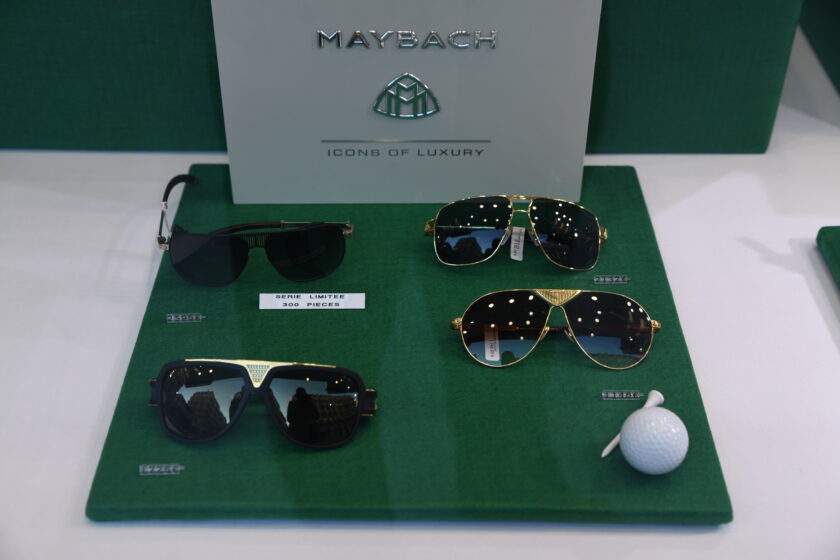
Today, sunglasses are one of the most common accessories worn by men in every style genre, from classic to trendy. Simple to wear, fun to see, and useful on sunny days, sunglasses can add a much-needed perfect finishing touch to any ensemble.
“With my sunglasses on, I’m Jack Nicholson. Without them, I’m fat and 60.”
Jack Nicholson
With the proper utilization of sunglasses, any outfit can be effortlessly elevated, all while extending a much-needed break to your eyes. In the next section of this guide, we will explain how sunglasses function and how you can find the perfect pair to suit your needs.
Men’s Sunglasses FAQ
What types of sunglasses look best on men?
Any Classic pair of sunglasses, when worn correctly with the proper outfit, can appear dapper and charming on a gentleman. When it comes to selecting the correct size and shape, however, you should base your selection on your face shape and skin tone. These results will be superior and ensure that your selected shades are the perfect complement to your face and personal style.
What is the best way to select a pair of sunglasses?
First and foremost, sunglasses should be selected according to your needs. If you are going to be engaged in intense athletic activities, you need sunglasses that are durable, protective, and stable. If you are interested primarily in styling your sunglasses based on your attire, you should keep formality in mind: brightly colored, oversized shades may look great on the beach, but well-proportioned black sunglasses are best for formal occasions. After settling on how you intend to wear your sunglasses, you should make your final selection based on the sunglasses that have the most pleasing effect on your face, usually determined by its shape and your skin tone.
What should I do with my sunglasses when not wearing them?
Just like with other glasses, the best rule for sunglasses is “on your face or in your case.” Following this advice will help to ensure that your sunglasses are accessible, secure, and scratch-free. It may be convenient to loop your sunglasses into the front of your shirt or your belt, but doing so increases the risk that the sunglasses could be dropped or damaged.
Are more expensive sunglasses worth it?
Sunglasses are often expensive for one of two reasons. The first is because the sunglasses are made from quality materials, like well-made lenses, that have a certain intrinsic cost. These sunglasses are worth investing in because they provide superior clarity, durability, and styling potential. Many fashion house sunglasses, however, are made from low-quality materials typical of cheap sunglasses, but with an elevated price because of brand status alone. Unless you specifically want to be wearing a particular brand, sunglasses in the latter category rarely represent a good value.
How do I stop losing my sunglasses?
If you have invested in a quality pair of sunglasses, it can be very frustrating to lose them. An easy way to keep track of your sunglasses is to keep them on your face or person. When you need to take them off, hang them from your shirt or belt, or put them into their case and then put the case into a shirt, trousers, or jacket pocket. Avoid putting your glasses down anywhere that is not your body, like on a ledge or table, as doing so makes it much more likely that your sunglasses will be left behind.
What do the two numbers on my sunglasses mean?
The numbers on sunglasses reflect the measurement of the lenses and the measurement of the space between the lenses over the nose. The first number indicates the width of the lens: the number 50, for instance, would mean that each of the lenses has an individual width of 50 millimeters. The second number indicates the distance of the bridge of the glasses, which is the section between the two lens frames just above your nose. These numbers can be useful when searching for glasses with a similar proportion to a pair that you currently own.
How do I know what shape for sunglasses is best for me?
The relationship between sunglasses’ shape and your face is complicated and involves a number of factors. Learn about all of them in our dedicated guide to selecting sunglasses based on your face shape.
Do sunglasses actually protect your eyes?
Properly-made sunglasses with the correct protection rating will protect your eyes and are a vital investment in the health and comfort of your eyes. Not all sunglasses, however, provide equal protection, and many cheap sunglasses with simple plastic lenses offer almost no protection from the sunlight. Therefore, it is important that you understand how sunglasses function to protect your eyes, a topic covered extensively in this guide.
What makes a pair of sunglasses more formal or more casual?
In general, matte dark sunglasses with simple, broad lines are more formal. Sunglasses that deviate from this standard, whether by featuring different colors, having extremely thin or oversized frames, or being made from shiny or highly noticeable materials, are more casual. As a rule of thumb, the more dramatically your sunglasses stand out, the more casual they are.
How many pairs of sunglasses should I own?
Ultimately, it is up to you how many pairs of sunglasses you own. Most men will benefit, however, from having at least two pairs, one of generally more formal sunglasses, and one pair of generally more casual. If you regularly engage in athletic endeavors, a third pair of more-durable sport sunglasses is also likely to be a great investment.
Should your sunglasses match your outfit?
While it is a good idea to harmonize your sunglasses with your outfits generally, they do not need to match exactly, and doing so can actually appear affected or distracting. Instead, you should purchase sunglasses that you know will complement most of your outfits, with various sunglasses to fit different levels of formality.
How long should a pair of sunglasses last?
If well-cared for, sunglasses’ frames can last for over a decade. The protective qualities of the lens in sunglasses, however, deteriorate in the sun, and can eventually be completely worn out. Most quality sunglasses will last for at least two years with daily, regular UV exposure before the lenses need to be replaced. Depending on the degree of use in direct sunlight, most pairs will last considerably longer.
How do I know if the protective layer on my sunglasses is still functioning?
Opticians can test your sunglasses to see if their protective layers are still intact. You can do the same test at home, however, with a UV flashlight and some paper money. Most high-value paper money has a watermark only visible under UV light. Using the UV flashlight, locate the watermark. Then, shine the light through the lenses. If you can still see the watermark, it’s time to get new lenses.
Should you wear your sunglasses indoors?
Unless they are being worn for medical reasons, it is not in keeping with the conventions of Classic Style to wear sunglasses indoors.
What are the differences between masculine and feminine sunglasses?
Sunglasses that are “for men” or “for women” are labeled as such only because of conventional styling cues that generally make a pair of sunglasses appear more feminine or masculine. Men’s sunglasses, for instance, tend to have cleaner lines and sharper edges, while ladies’ sunglasses tend to have more organic shapes and rounded lines. These distinctions are purely social constructions, however, so if you enjoy how a pair of sunglasses make you look, you should wear them regardless of the sex for which they were originally marketed.
How Sunglasses Work
Sunglasses Protect Your Eyes from Harmful Rays
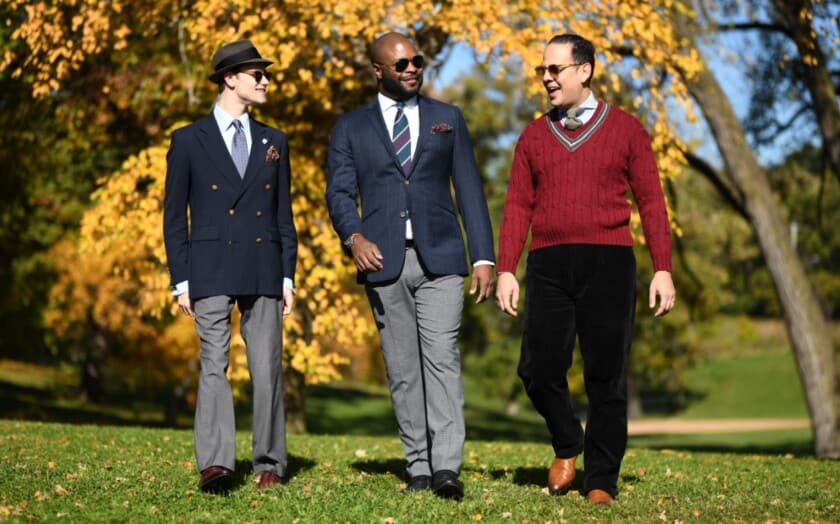
The primary usefulness of a pair of sunglasses comes from its ability to protect your eyes. Contrary to popular assumptions, the sun’s glare, which you can see, is not the main culprit for ocular damage. In fact, the greatest harm is caused by the ultraviolet, or UV, rays, that you cannot see and can cause both short-term and long-term ocular degeneration or impairment.
“If your eyes are exposed to excessive amounts of UV radiation over a short period of time, you will likely experience photokeratitis. Like a “sunburn of the eye,” photokeratitis can be painful, with symptoms including red eyes, a foreign body sensation or gritty feeling in the eyes, extreme sensitivity to light and excessive tearing. Fortunately, these symptoms are usually temporary and rarely cause permanent damage to the eyes.”
The American Optometric Association
Fortunately, advancements in optical science have made lenses that can fully protect against harmful UV rays very affordable – you can benefit from full UV protection without having to break the bank, although quality lenses will still represent an investment.
Always bear in mind that the protection afforded by sunglasses cannot be seen. Darker lenses do not offer more protection. The only way to ensure optimal protection from the sun is to purchase from trusted retailers, and for further peace of mind, have them tested or made by a qualified optician.
Understanding Ultraviolet Light
UV light is a particular spectrum of light, whose wavelengths are measured in nanometers, that is primarily emitted by the sun and can cause harm with long-term exposure. There are three types of UV light, defined by their wavelength: the longest, UV-A, UV-B, and UV-C, the shortest, although the last example is completely absorbed by the ozone layer. The best sunglasses will offer protection against both UV-A and UV-B.
| Ultraviolet Light | Effects of Exposure |
|---|---|
| UV-A | Prolonged exposure to UV-A can lead to wringing, hyperpigmentation, and other symptoms of damage to the skin. There is also some evidence that UV-A can, over time, weaken the immune system, encourage the growth of cancers, and harm the retina, potentially leading to blindness. |
| UV-B | UV-B does the most immediate harm to the body and is primarily responsible for causing sunburns. It can also damage the surface cells of the eye’s cornea, causing pain, blurred vision, and temporary blindness with protracted exposure. |
Quantifying Sunglasses Protection Potential
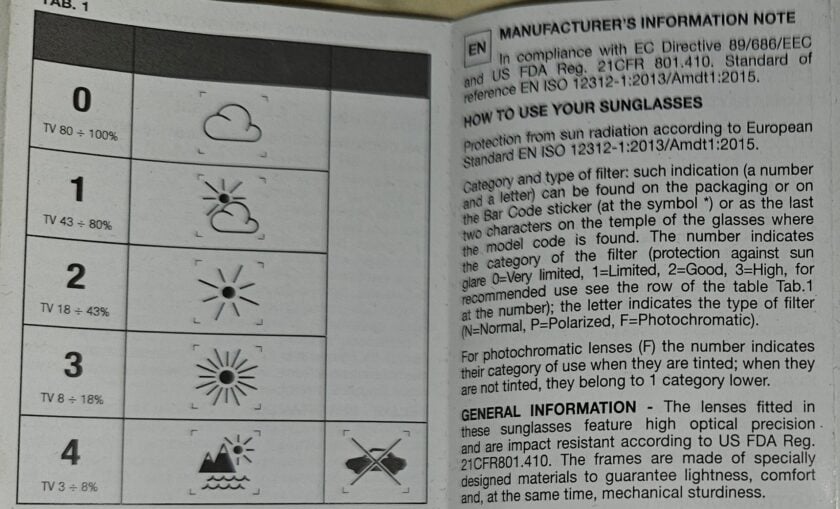
Today, there are three sets of standards typically used by the various sunglasses manufacturers.
- The Australian Standards, codified as AS/NZS 1067:2003, regulate both spectacles and sunglasses using five ratings for the filters from 0-4 based on absorbed light. The higher the number, the better the protection.
- The European Standard, appearing in the lawbooks as EN 1836:2005, offers four ratings as well, with “0” for insufficient UV protection, “2” for sufficient UHV protection, “6” for good UHV protection, and “7” for “full” UHVV protection, meaning that no more than 5% of the 380nm rays are transmitted. Some experts, however, believe that “full” protection should instead be calculated relative to 400nm, and so by some metrics, the EU standards fall short.
- In the United States, sunglasses are regulated by the Food and Drug Administration (FDA) under ANSI Z80.3-2001, which uses three transmittance ratings. The highest rating ensures adequate protection against both UV-B and UV-A light, which has a maximum wavelength of about 400 nm. The FDA also accounts for basic impact and high-impact protection. In the basic impact test, a one-inch steel ball is dropped on the lens from a height of fifty inches. In the high-velocity test, a ¼ inch steel ball is shot at the lens at 150 feet per second. To successfully pass both tests, no part of the lens may touch the eye. Because of the breadth of these tests, the FDA standards are usually considered superior to other systems.
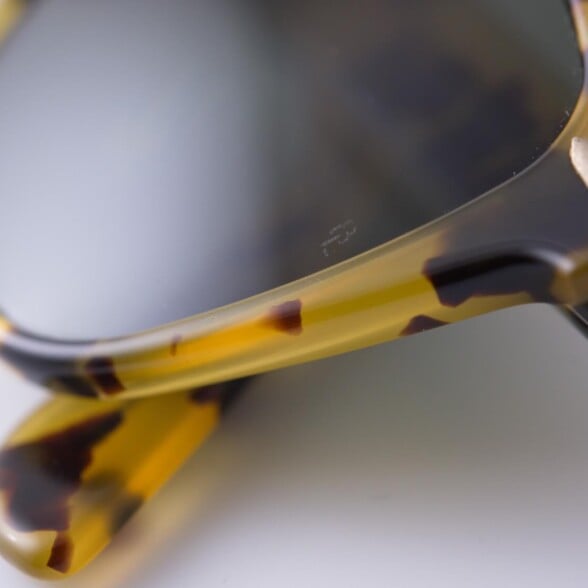
The Benefits of Optical-Quality
Lenses
Between the high prices of designer shades and the inferior quality of cheap models, there is a middle option that offers the quality of the former without its inflated prices. Sunglass lenses bought seperately from frames that emphasize genuine optical quality benefit from superior depth perception, higher contrast, resistance to scratches, and overall superior. While they may have less of an emphasis on aesthetic appeal, Carl Zeiss and Randolph Engineering both offer exceptional quality at a very reasonable price point.
Lens Options for Sunglasses
The Lens Are Technically the Most Important Part of the Glasses
When it comes to the protection, comfort, and functionality of sunglasses, the lenses of the glasses are the most important aspect. The material from which they are made, their color, and any coatings they have will define the primary functional aspects of the sunglasses.
Lens Materials
The lenses of sunglasses can be made from a variety of materials. Each material has particular qualities and characteristics that make it suitable or unsuitable to different types of uses or styles. When possible, you should endeavor to select a lens glass that fulfills your desired needs while remaining within your desired price point.
- Plastic – The most common lens material on the market today, plastic is employed in both cheap and high-end sunglasses. Light and largely shatter-resistant, plastic lens quality varies drastically based on a variety of factors. At its most basic level, plastic lenses have no real UV protection qualities and can be cloudy or distorting, if made from low-quality plastic. Higher quality models, however, leverage the lightness of plastic with the addition of UV protection in the form of additives or special films.
- Glass – Made from genuine glass to ensure clarity, glass, due to its relative expense, is usually employed only for higher-quality sunglasses. While glass can be treated to reduce scratching and resist impact, ultimately, it is more frangible than most other lens materials and can be catastrophically damaged when crushed or dropped.
- Polycarbonate – This synthetic material attempts to provide the clarity of glass with the strength and light weight of plastic. It can be delicate, however, and potentially prone to flaking or scratching.
Relative Darkness of Lenses
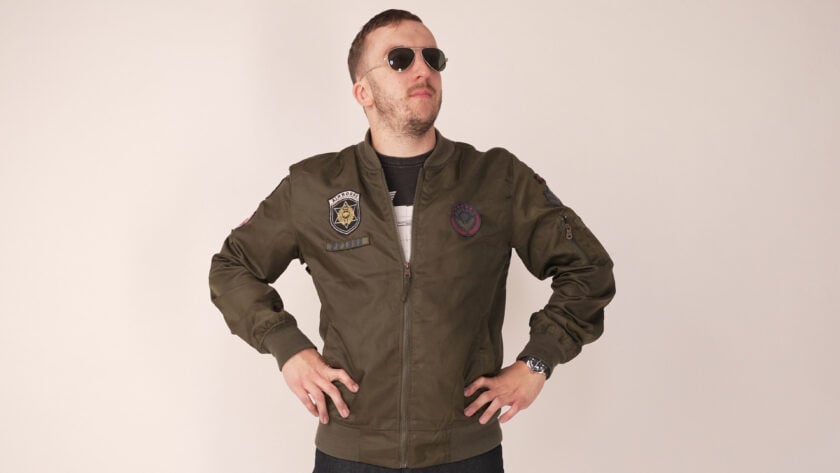
As previously mentioned, how dark lenses appear does not necessarily correspond to the amount of sun protection that they provide. Despite not necessarily offering more protection, they may serve a very valuable purpose to the consumer. The two most popular reasons for purchasing dark are wanting to prevent people from seeing your eyes due to personal or professional reasons or for individuals with ocular deformities, such as members of the blind community.
These glasses are especially popular with professional servicemen and women such as police officers, military personnel, and security guards, who wear them either to hide their facial expressions or for intimidation purposes. In professional gambling such as poker, many players will wear dark sunglasses to prevent their opponent from reading their “tell” or eye movements that could give away their hand (or lack thereof).
Ultimately, how dark your lenses are is a personal choice that should be dictated by how you intend to wear your sunglasses.
Lens Coatings
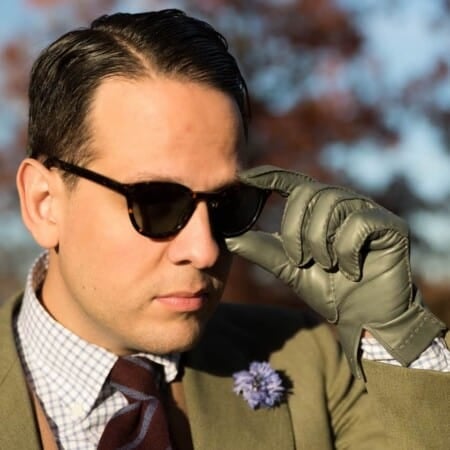
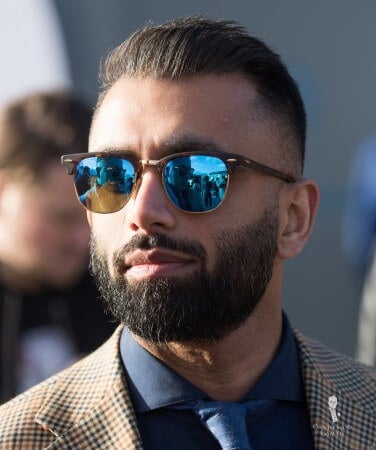
The lenses of glasses can be coated so as to improve their functionality and efficiency. These coatings are applied during the production process and can often be utilized together for a superior combination of useful traits and characteristics.
| Coating | Notes |
|---|---|
| UV-Protection | Whether built into the lens itself or applied as a coating, UV protection comes from chemicals that absorb UV light and prevent it from entering your eye. Over time, the chemicals that absorb the UV light break down and will need to be replaced. |
| Anit-Reflective | This coating reduces the amount of light that is reflected in the eyes from the sun. As a result, it reduces glare overall and helps to eliminate the light halos that can form around certain reflective objects. |
| Photochromic | Commonly found on eyeglasses, photochromic lenses change their tint based on light conditions, becoming transparent indoors but darkening when exposed to UV light. Branded as Transition Lenses, these lenses effectively combine the benefits of eyeglasses and sunglasses into one pair of glasses. |
| Polarized | As mentioned above, the application of a polarizing film over the lenses blocks polarized light waves. Because these waves are usually reflected off of horizontally polarized surfaces, like water or paved surfaces like roads, they tend to produce a considerable amount of glare, and so polarized lenses can be extremely useful for regular wear. |
| Mirrored | In bright conditions, mirrored lenses reflect back reflected light, reducing overall glare. They are an alternative for users who dislike the effect of polarized lenses, although they can also be used together. Mirrored films can also be useful for those wishing to obscure their features or the movement of their eyes, and are often associated with the military, law enforcement, and poker players. |
| Gradient | These lenses have a variable tint over the surface of the lens, being either more or less tinted at the top than the bottom. This variation helps to filter out extreme brightness, therefore reducing glare, with less impact on overall clarity and contrast. |
| Scratch-Resistance | This thin layer of durable material is laid over the exterior of the lenses, to help prevent scratches to the delicate lenses. While not necessarily able to protect against drastic trauma, high-quality scratch-resistance lenses can protect against most forms of regular wear-and-tear and extend the life of your sunglasses overall. |
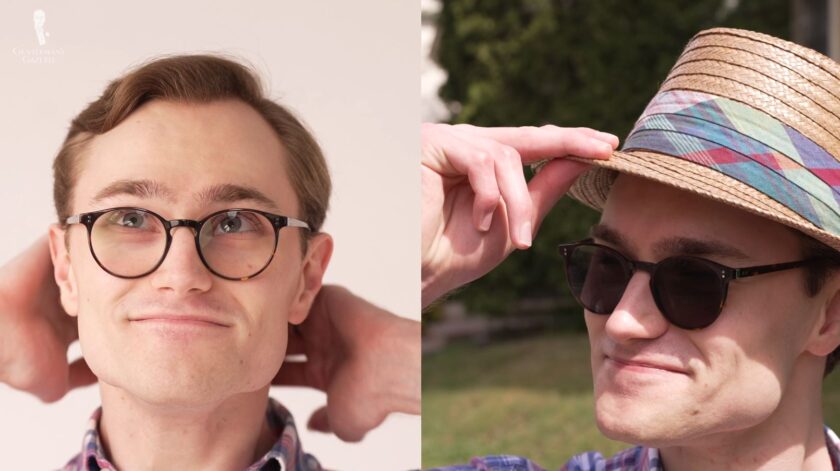
Common Lens Colors
While they can have an aesthetic impact on your sunglasses, the color of your lenses will also impact how they function and how objects appear when viewed through them. Tinted lenses can be especially important to consider when you are wearing sunglasses while engaged in sport or athletics.
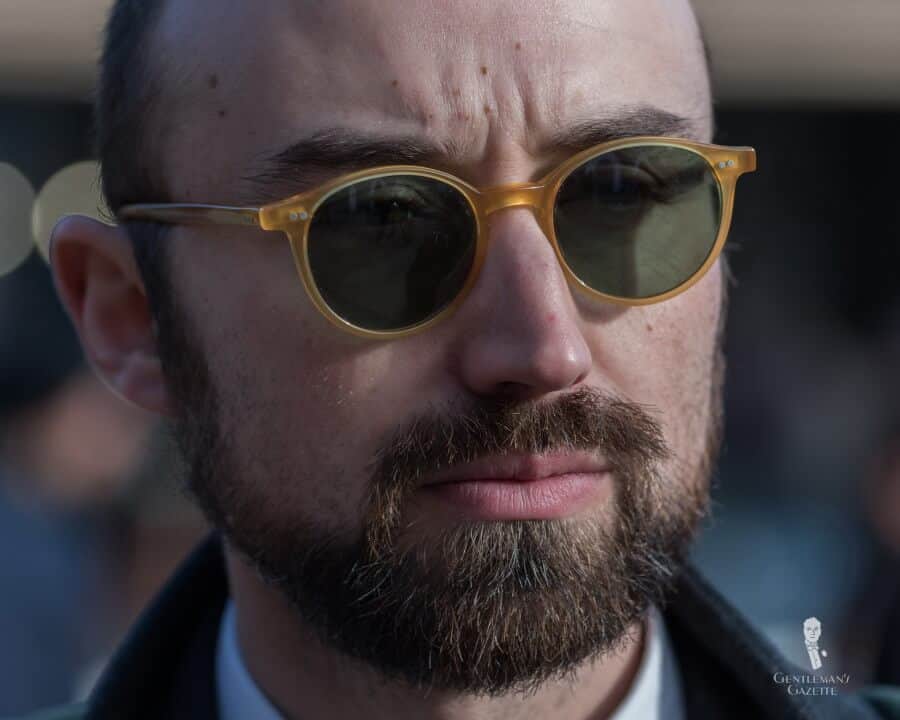
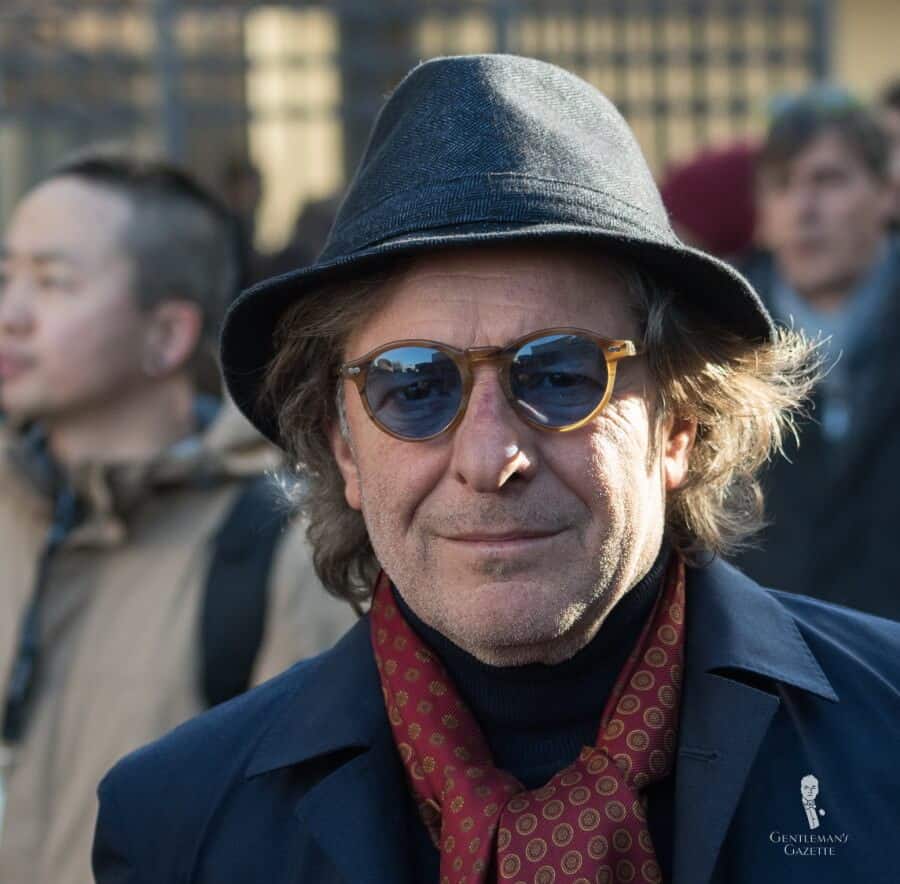
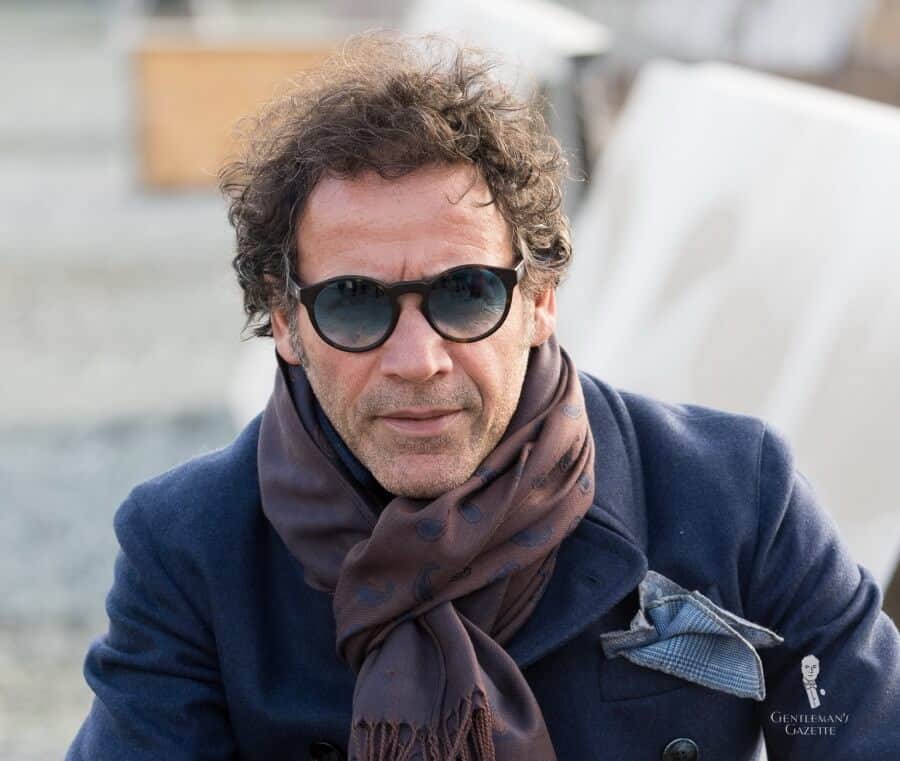

- Gray – Because they are color-neutral, gray lenses reduce excess light while mitigating color distortion. This improved clarity under normal conditions, as well as its unobtrusive appearance, make gray lenses ideal for regular wear, especially when driving.
- Yellow or Orange – Although lenses of this color can potentially distort other colors, they do provide improved contrast in low-light conditions. They are, therefore, often associated with outdoor sports or pursuits that take place in the early morning, evening, or under any imperfect light conditions.
- Brown or Amber – By blocking blue light, lenses of this color heighten image contrast. They tend to improve overall clarity, although at the cost of distorting some colors, especially yellow. They also cut glare well, and as such, are suited for conditions with extreme sunlight, like days at the beach, or sports played on highly reflective courts or surfaces.
- Green – This tint works by filtering out blue light, and as such, reduces glare while providing exceptional contrast without sacrificing color balance. For activities in which accurate sighting over distances is valuable, such as polo, golf, or baseball, or immediate sighting at high speeds, like tennis, these lenses can be an excellent option.
- Purple or Red – Although lenses of this color can cause significant color imbalance, they also offer superior contrast in both cloudy and sunny conditions. As such, they can be very useful for those who experience extreme light sensitivity when driving, or when undertaking outdoor athletic endeavors in extreme light conditions.
- Blue – Lenses of this tint primarily filter out white light and, as such, are most commonly worn when glare is extremely high, usually in snowy conditions. They are commonly associated with snow sports like snowboarding or skiing, but can also be found at the beach, in desert environments, and sometimes when driving.
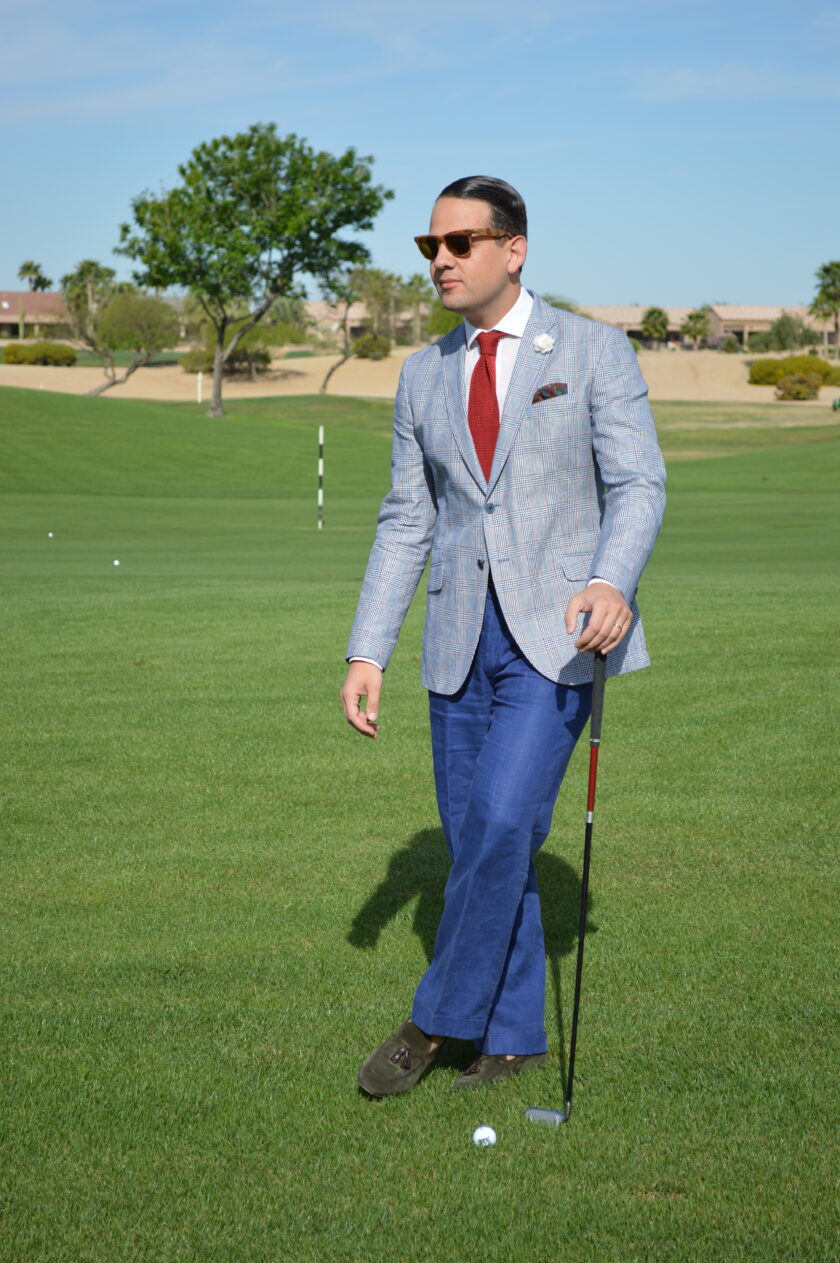
Sunglasses Have an Expiration Date

The rays of the sun can be extremely damaging, and that damage can even happen to things meant to protect from it. Over time, continual exposure to the sun can cause the protective layers on the lenses of sunglasses to break down, compromising the protective qualities of the lenses. When this occurs, the sunglasses will no longer provide the best possible protection and should ideally be replaced. Most quality pairs of sunglasses can endure at least two years of regular, daily UV exposure before needing to be replaced. Many pairs will last even longer if not worn regularly in direct sunlight.
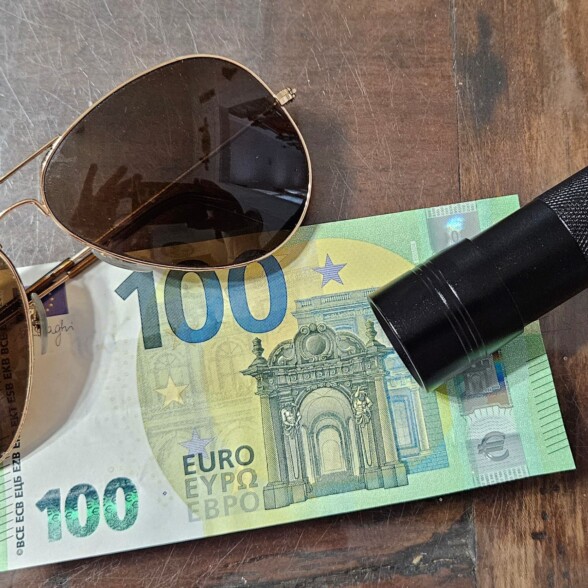
How to tell if your sunglasses have
Expired
Opticians can test your sunglasses to see if their protective layers are still intact. You can do the same test at home, however, with a UV flashlight and some paper money. Most high-value paper money has a watermark only visible under UV light. Using the UV flashlight, locate the watermark. Then, shine the light through the lenses. If you can still see the watermark, it means that the lens is no longer blocking the UV light, meaning that they need to be replaced to be fully effective.
How Sunglasses Should Fit
Find the Right Fit Every Time
In ideal conditions, the correct fit of sunglasses will perfectly balance the needs of protection, eye coverage, and style, resulting in a functional fit that looks great while helping you see well. Of course, sunglasses are not very useful if they do not help improve your vision, so your primary concern should almost always be to ensure proper ocular health and functionality, which is achieved by frames that sit as close to the eye as possible to prevent stray light from entering through the sides or the top.
We have created a dedicated video on this subject that will help you find the perfect fit for your sunglasses, but you may also benefit from the advice of a professional.
The Benefit of Buying Sunglasses from an Optician
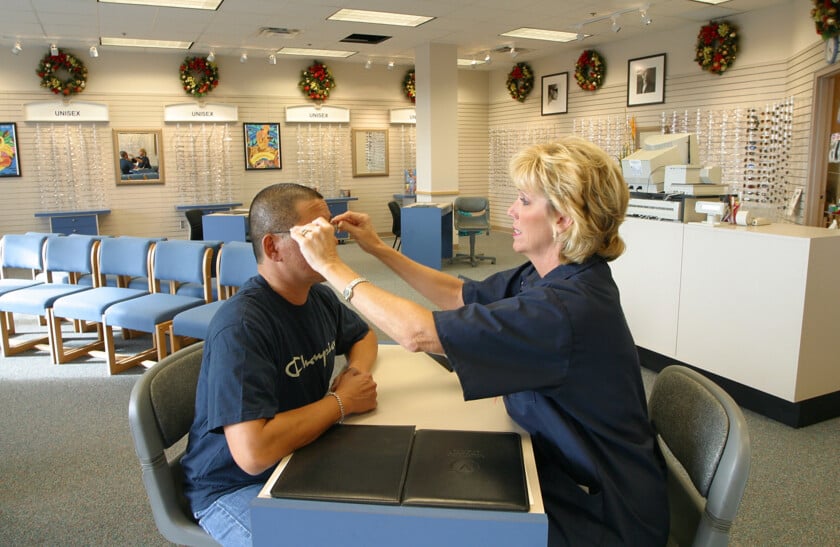
While various types of stores sell everything from dollar-brand sunglasses to designer frames, you can achieve the best possible fit by buying your sunglasses from a licensed optician. In today’s era, most opticians will feature a wide selection of designer frames, as well as budget frames, for the price-conscious consumer.
Most spectacles can also be made into sunglasses, and it’s only by visiting one of these opticians that you’ll be certain to obtain the best fit for your face because they can quickly adjust frames to your particular needs. While retail stores like The Sunglass Hut offer a great selection of designer frames, their sales representatives have very limited ocular training, especially when compared to trained medical professionals.
Should you buy your sunglasses
Bespoke?
If you are willing to invest the time and money into it, a pair of bespoke sunglasses could be ideal for you. In addition to the best possible fit, bespoke sunglasses also offer the opportunity to select the exact lenses and frame materials that you want, crafting a truly custom pair of sunglasses to suit your needs. Be aware, however, that this undertaking could easy cost thousands of dollars.
Find the perfect fit for eyeglasses, too!
Sunglasses Frame Materials
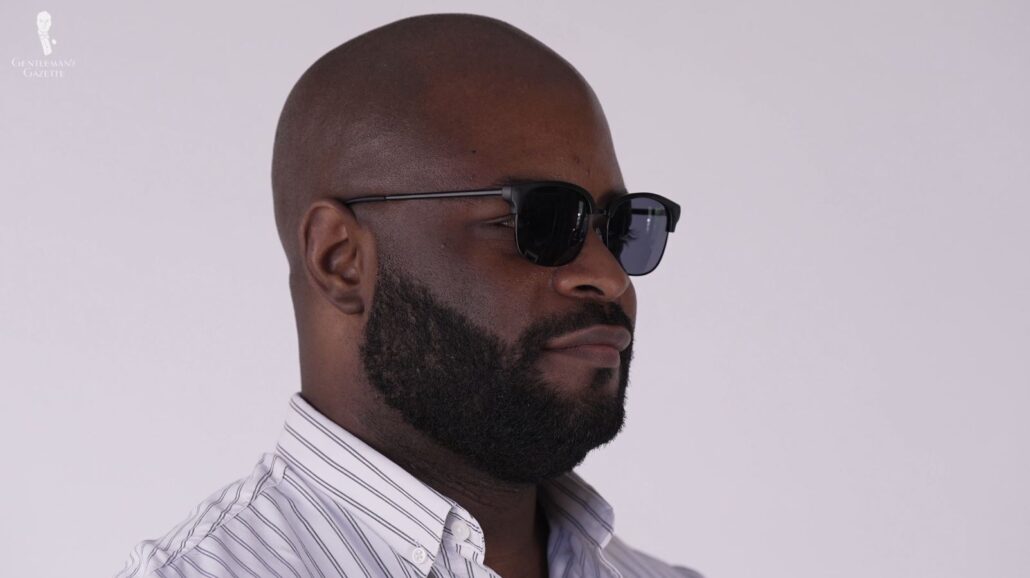

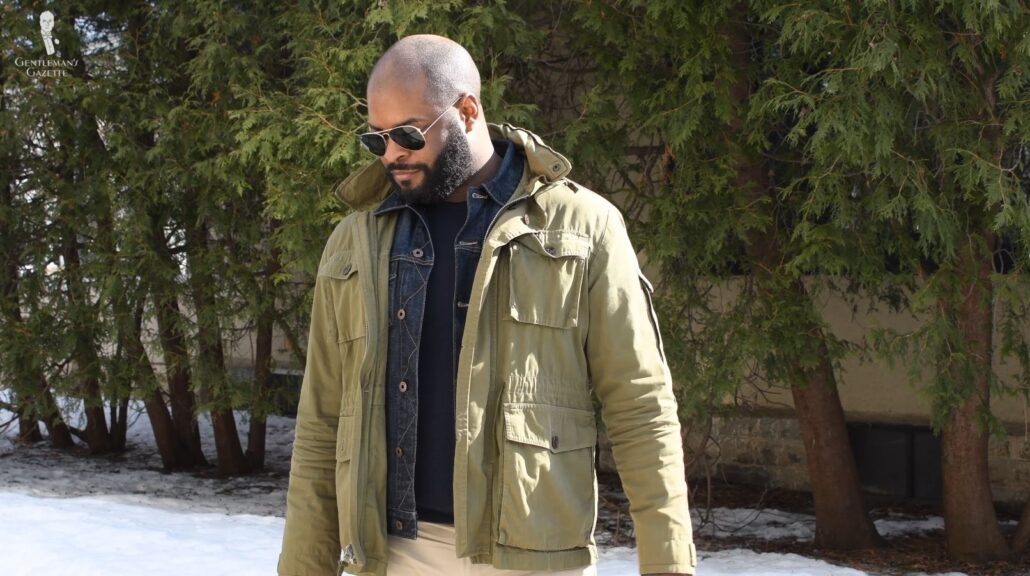
Frame Material Impact Appearance, Durability, and Functionality
Not all sunglasses are created equal, and while the lenses are very important, you must not underestimate the impact of a great frame. The shape of the frame, as well as the materials used, play a huge role in the look and longevity of the sunglasses.
Injection-Molded Plastic
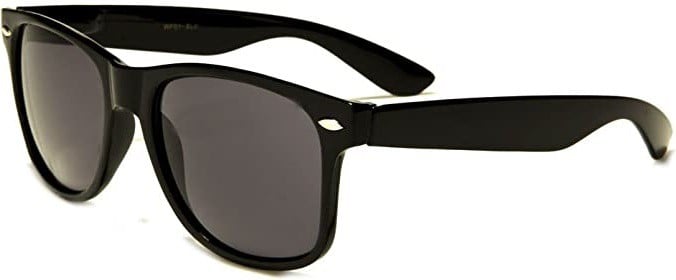
This is, by far, the number one method used in the making of sunglasses frames because it is inexpensive when produced on a large scale. First, petroleum-based plastic is liquefied and then injected into a mold. Once cooled off the plastic is solidified into a frame. Colors are often added in layers of spray paint and coatings because it is less expensive.
Obviously, the advantage of this procedure is that it involves very little wastage; it is very inexpensive for the manufacturer, and the frame can be bent and shaped into form very easily. On the other hand, it doesn’t look as attractive as acetate or horn frames, and it feels cheaper and less durable.
Overall, injection molded sunglasses simply lack the characteristics necessary to represent good value relative quality, yet almost all designer sunglasses today are made that way, just like the $3 sunglasses from street vendors. Obviously, you can’t trust the pricetag to guarantee quality.
Acetate
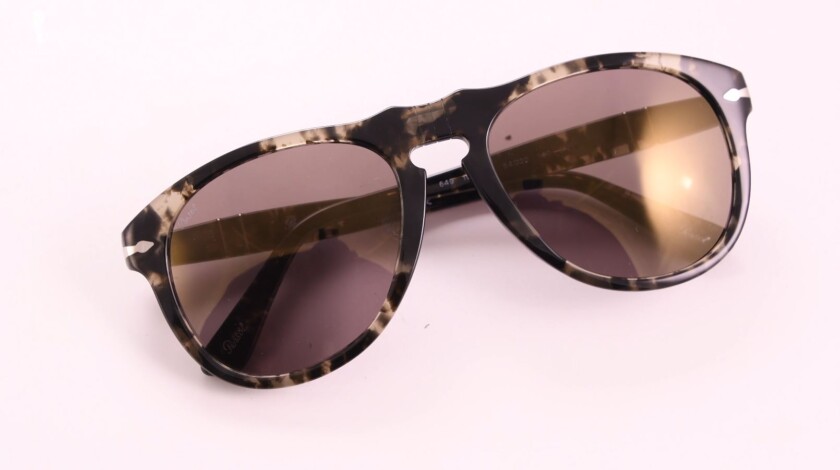
Acetate is derived from cellulose such as cotton or tree fibers and is thus often referred to as plant-based plastic. Sometimes also called Zyl, it is the highest quality plastic used in the eyewear industry. Acetate is strong, lightweight, and flexible while providing the widest range of transparency, color richness, and finishes of all materials used for making sunglasses. It can even be applied in layers of different colors resulting in countless sunglasses options.
The production of a frame starts by forming layers of plastic into a block of acetate which is usually about 3 feet or 90cm long and about 1cm thick. The parts of the frame are then cut with a pantographing machine from this block before they are hand-polished and assembled.
The advantages of cellulose acetate are that it is made of renewable material, unlike petroleum-based plastic, it is lightweight, hypoallergenic, and extremely flexible. On top of that, it is more durable than injection-molded plastic, and it offers a much greater range of transparency, color variation, and so forth. On the other hand, it is more expensive to produce than injection-molded frames.
The fact of the matter is, on basically every objective point, acetate is superior to injection molding, but because of the higher price, manufacturers prefer injection molding.
Metal
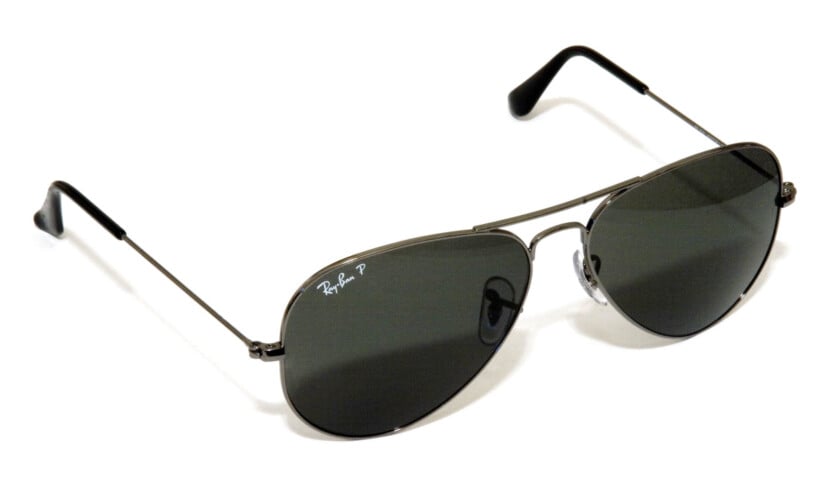
Historically, many sunglasses were made from different types of metal, and this material is still used today, although the rising cost of materials has made it less popular.
Monel frames, made of a copper-nickel alloy, are very cost-effective, while titanium eyeglass frames are super sturdy and lightweight. Stainless steel sunglasses frames are made mostly of iron, resulting in a sturdy, heavier frame that is corrosion-proof, whereas nickel silver frames are made from zinc, copper, and nickel, which can cause skin reactions and often tarnishes with age.
From a functional perspective, titanium or iron frames are sturdier and require less intensive maintenance, whereas most other alloys usually have low durabilty and are not suggested for people with sensitive skin.
Wood
In recent years, wood has also become popular as a material for sunglasses frames. In the beginning, it was only found in high-end sunglasses or custom frames, but it has now become more common thanks to innovations in manufacturing techniques. Lightweight and unique, wooden frames can be a great option if you prefer a unique look to your shades, but be aware that unless properly sourced wood and treatments are employed, wooden sunglasses can suffer from cracking, bulging, and warping.
Water Buffalo Horn
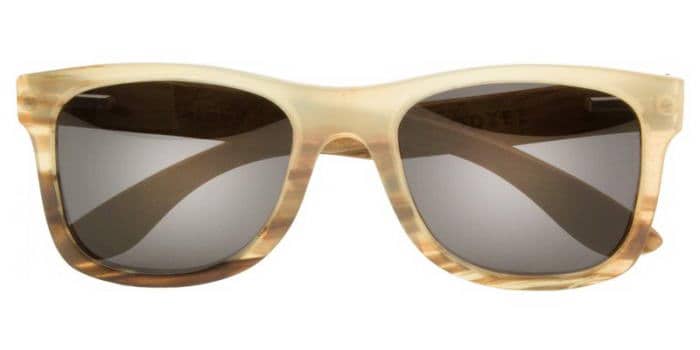
Although frames that look like horn are often made from acetate, real horn provides a very different look and feel. Owners of horn glasses appreciate the fact that the frame heats up to body temperature, making it very comfortable to wear, and, overall, provides a more solid and luxurious build.
At the same time, horn frames are very difficult to adjust and considerably more expensive than acetate or injection molded frames. If you want horn sunglasses, it may be worth investing in a bespoke pair or seeking out a maker who offers different sizes because adjustments are rather difficult to make. Sometimes, you will see acetate frames with a horn veneer, but this is mostly done for price reasons, and while it can work, it’s not quite like a real water buffalo horn frame. Unlike acetate, the range of colors is very limited, and because it is a natural material, you will always get a one-of-a-kind frame.
Genuine Tortoise Shell
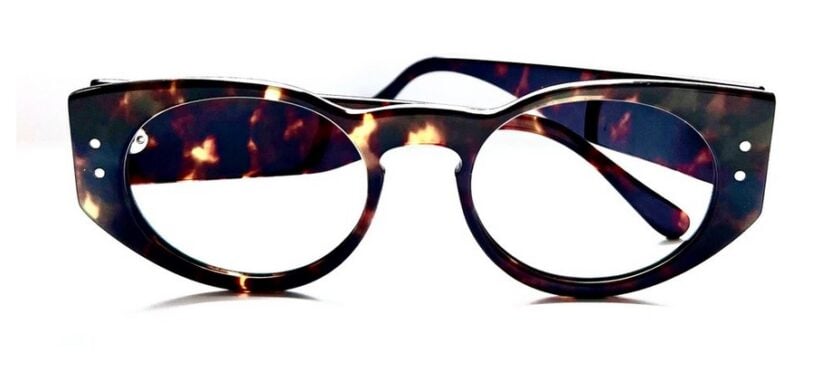
While “tortoiseshell glasses” usually refers to the color and design of the frames, and not the material used, real tortoise shells can also be used in high-end sunglasses. In fact, some of the most expensive frames in the world are made from genuine tortoise shells.
With its unique luster and color, tortoiseshell glasses are considered some of the most beautiful in the world. Note that genuine tortoiseshell turns matte over time, so it also needs to be polished on a regular basis.
This material is derived from the shells of a larger species of tortoise, the hawksbill turtle, which is an endangered species due largely to the exploitation of this material. Therefore, the trade of tortoiseshell worldwide was banned under CITES in 1973. However, if you can prove that the tortoiseshell was harvested before 1973, you can still use it to make sunglasses frames.
Because of regulations, expect to pay $15,000 to $20,000 for a frame.
Sunglasses Frame Construction
Frame Construction Dictates Functionality
The frames of sunglasses, like spectacles, come in a variety of forms. From plastics and metals to various alloys, there is a wide range of styles available. How the frames are made will considerably impact the look of your sunglasses, as well as how they function.
| Frame Info | Notes |
|---|---|
| Full Frame | Full-frame sunglasses are often made of plastic or metal. Usually worn as sports sunglasses, the frame wraps around the entire lens, offering the most protection available from elements such as debris and wind. Typically, for those who require sunglasses for professional purposes, full-frame glasses are the standard. |
| Half Frame | Half-frame sunglasses are exactly what they sound like. Generally, the frame will cover the top and sides of the lens but not the bottom. This allows a certain balance between the protection afforded by full-frames but with reduced visual and actual weight. |
| Frameless | Frameless glasses have no frames. The stem that holds the frame in place and the nose bridge is attached directly to the lens itself. The nose bridge is the support structure that protects the lens and the face. It can help to prevent friction, pressure and provide even weight distribution. |
| The Nose Bridge | The nose bridge is one of the most integral parts, as it impacts the style. As a general rule, if you have a larger nose, the nose bridge should be lower, whereas people with smaller noses need one that is higher. The nose bridge, in addition to the shape of the glasses, is the predominant factor that affects how good the sunglasses will look on the person wearing them. |
How To Pick The Right Sunglasses For You
Find the Style that Suits You and Your Needs

Finding the correct sunglasses can be a difficult feat, as you need to balance your face shape, your personal style, and the effect of the sunglasses to find something that works for you. The pursuit of quality is also complicated by the fact that most sunglasses brands are owned by a handful of conglomerates that focus more on hyping brand names than offering genuine quality and good value.
Nevertheless, with attention to detail and hard work, you can find a pair of sunglasses that is sure to complement your style, protect your eyes, and offer good cost-per-wear.
Below, please find an introduction to several common styles and brands of men’s sunglasses to help you get started. You will also find a table highlighting the varieties of price points available and links to additional Gentleman’s Gazette content to help you make an informed decision.
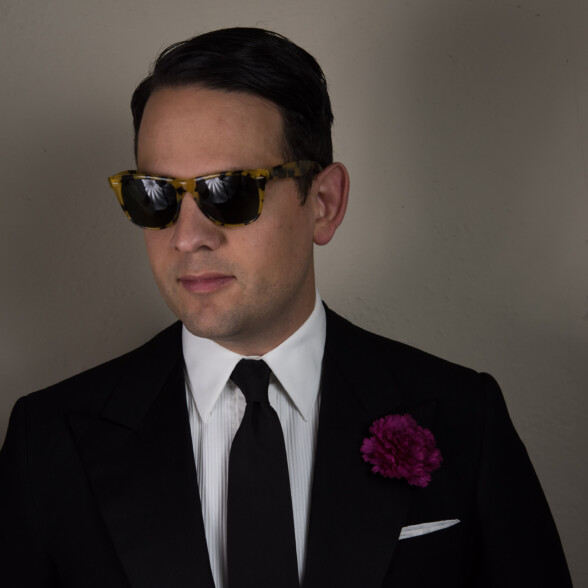
Understanding Sunglasses
Formality
Like all accessories, sunglasses have formality, too. In general, matte dark sunglasses with simple, broad lines are more formal. Sunglasses that deviate from this standard, whether by featuring different colors, having extremely thin or oversized frames, or being made from shiny or highly noticeable materials, are more casual. As a rule of thumb, the more dramatically your sunglasses stand out, the more casual they are.
These are our four essential sunglasses for men!
Aviator
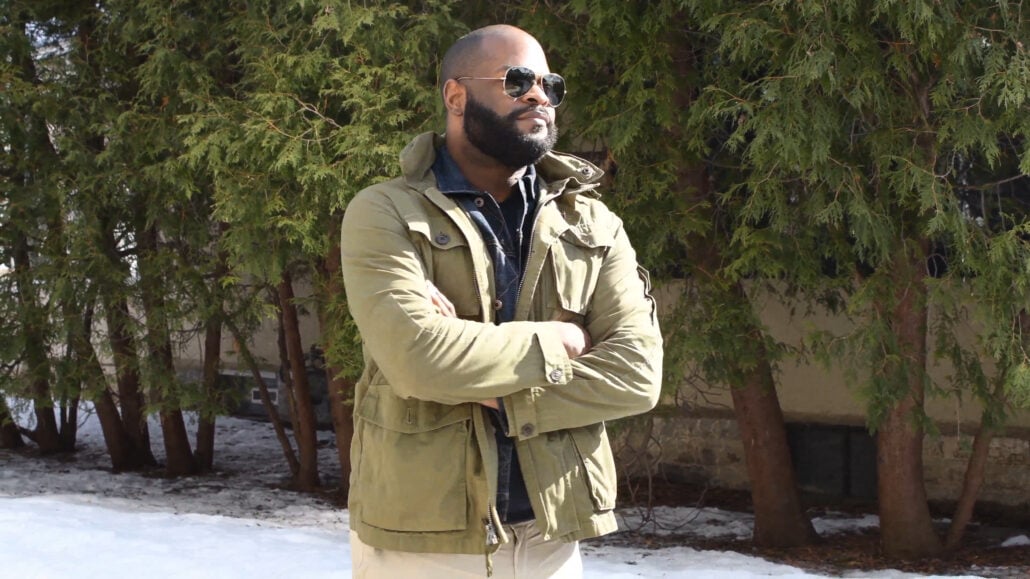
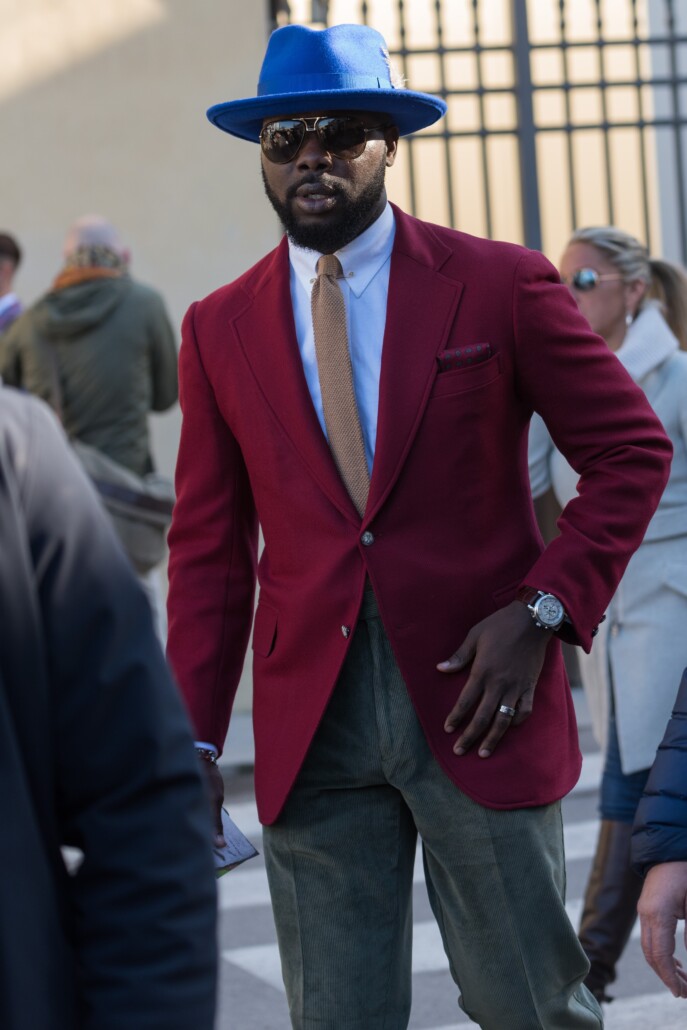
Originally designed in 1936 by Bausch & Lomb as Ray-Ban Aviator Sunglasses, these sunglasses were made for pilots, but starting in 1937, they also made them available to the public. General Douglas MacArthur wore them when he landed in the Philippines during WWII, and they became popular again in the 1960s with the Beatles, and in the 1980s because of the movie “Top Gun.”
Today, you can find many variations of this style that is characterized by large, slightly convex lenses. Considering that this style has been around for ages, you can’t go wrong in owning at least one pair. Ray-Ban still sells their “original” aviator style as RB3025, but you can also find gas station versions for $5 or more expensive interpretations from brands like Oliver Peoples, Randolph Engineering, or even a version in solid 18K gold for $3,200, which is sold over 1,000 times a year despite its weight of almost 2 pounds!
Take off with our Aviator Sunglasses Guide!
Round

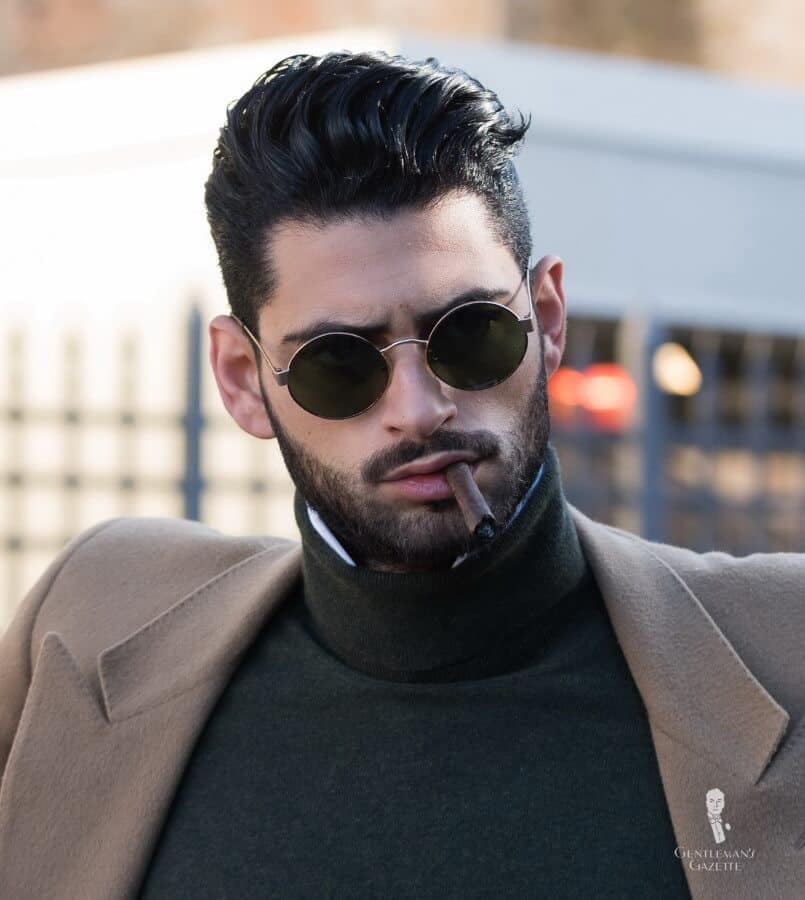


Dramatic and bold, round sunglasses often have a distinctive vintage feel and are often associated with a creative personality, eccentricity, and a desire to attract attention. The most famous pair of round glasses were worn by Franco-Swiss architect Charles-Edouard Jeanneret, known professionally as Le Corbusier. Consisting of thick black frames, the simple glasses were made by the Parisian firm Maison Bonnet, which also collaborated with Yves Saint Laurent.
If you are considering round sunglasses, be sure to try them on in person, as the precise size, proportion, and spacing of the frames is particularly important when the sunglasses themselves are so simple in design.
Wayfarer

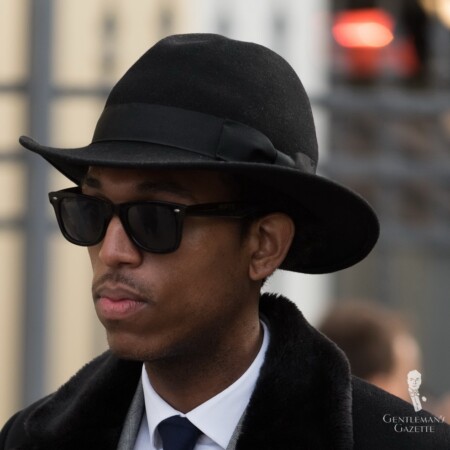
Ray-Ban Wayfarer Sunglasses are probably the best-selling style of sunglasses worldwide. As such, you can find many adaptations and imitations, and even Ray-Ban now offers four different kinds of wayfarer styles!
Originally designed by Raymond Stegeman for Bausch and Lomb, the then-parent company of Ray-Ban, they were considered to be a radical design change away from metal frames. Overall, the design was in line with the entire mid-century modern movement. First manufactured in 1956, Ray-Ban Wayfarers gained some popularity, which had all but faded by the 1970s. In 1981, the film “Blues Brothers” featured them, and sales totaled 18,000 that year.
Recognizing the importance of product placement, Ray-Bans began to spend tens of thousands of dollars to have studios insert their products into movies and TV. As a consequence, Ray-Ban sunglasses, especially Wayfarers, appeared in more than 60 films over the following six years, and that proved to be very effective.
“These sunglasses are so popular now that you cannot swing a canvas bag at a farmer’s market without hitting a pair.”
Christian Lander
By 1983, 300,000 pairs of sunglasses were sold, and in 1986, 1.5 million! Subsequently, the trend died down somewhat, and Ray-Ban redesigned the frame, attempting to improve wearability. In particular, the arms were adjusted to make it easier to tilt the shades from the temple over the forehead to rest on top of the cranium.
The most high-quality Wayfarers still readily available on the market today are from the 1980s, made of acetate with Bausch & Lomb lenses. As such, new and old stock pairs often fetch $500 or more on eBay, depending on the style.
Set sail with our Wayfarer Sunglasses Guide!
Clubmaster
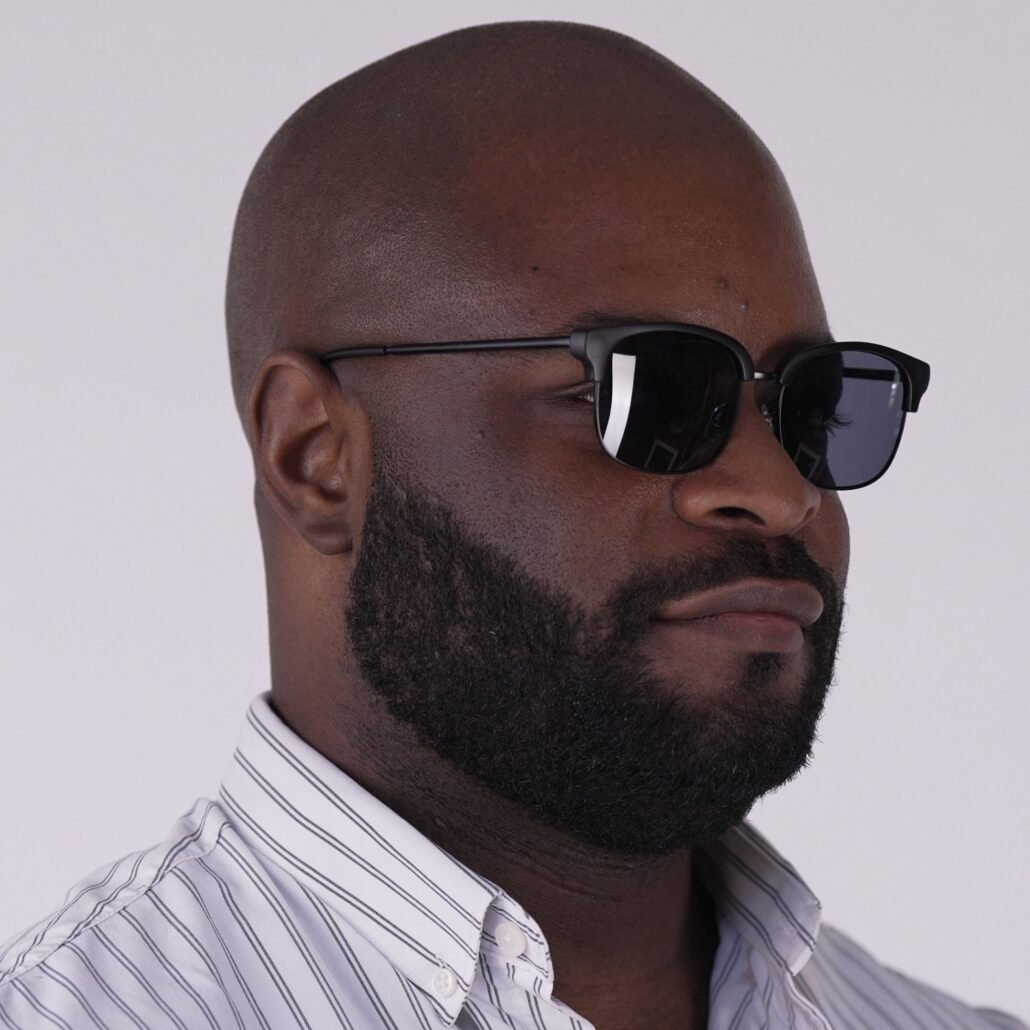

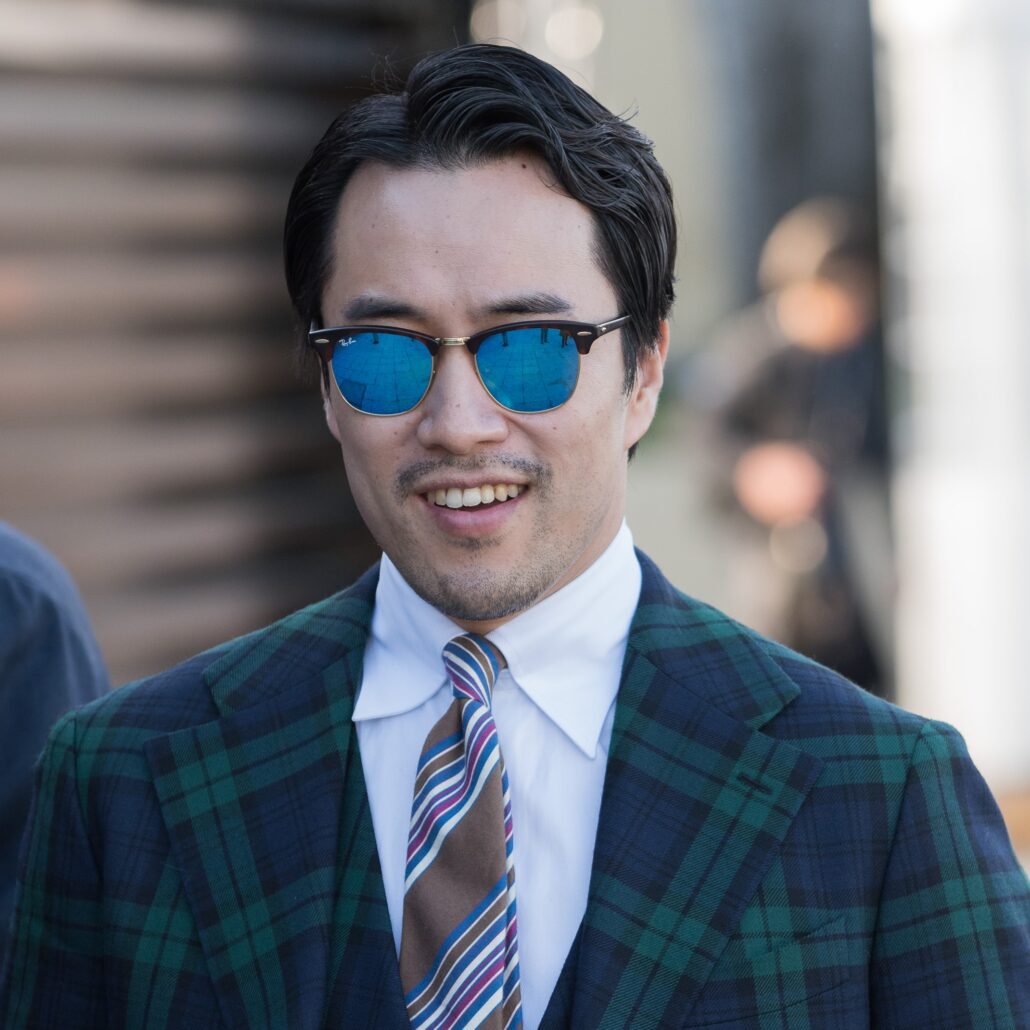
Evolving from browline sunglasses that were popular in the 1950s, Clubmaster sunglasses are designed with an upper frame that is thicker or appears bolder than the bottom portion of the frame. Traditionally, the upper — known as the brow or cap — is made from thick plastic or acetate that is also used on the temples. However, the remainder of the frame, including the bridge and eye wires, is usually made of metal. In more contemporary frames, the design can sometimes replicate a round sunglass but use a lighter shade or different plastic on the bottom to showcase the upper portion of the frame.
They come in a range of color combinations, sizes, and variations, so this is a great classic frame that can suit most face shapes, sizes, and complexions, given the range of options out there. Most Clubmasters would have originally come in black or tortoiseshell with silver or gold rims.
Master Clubmasters Sunglasses with our guide!
Persol
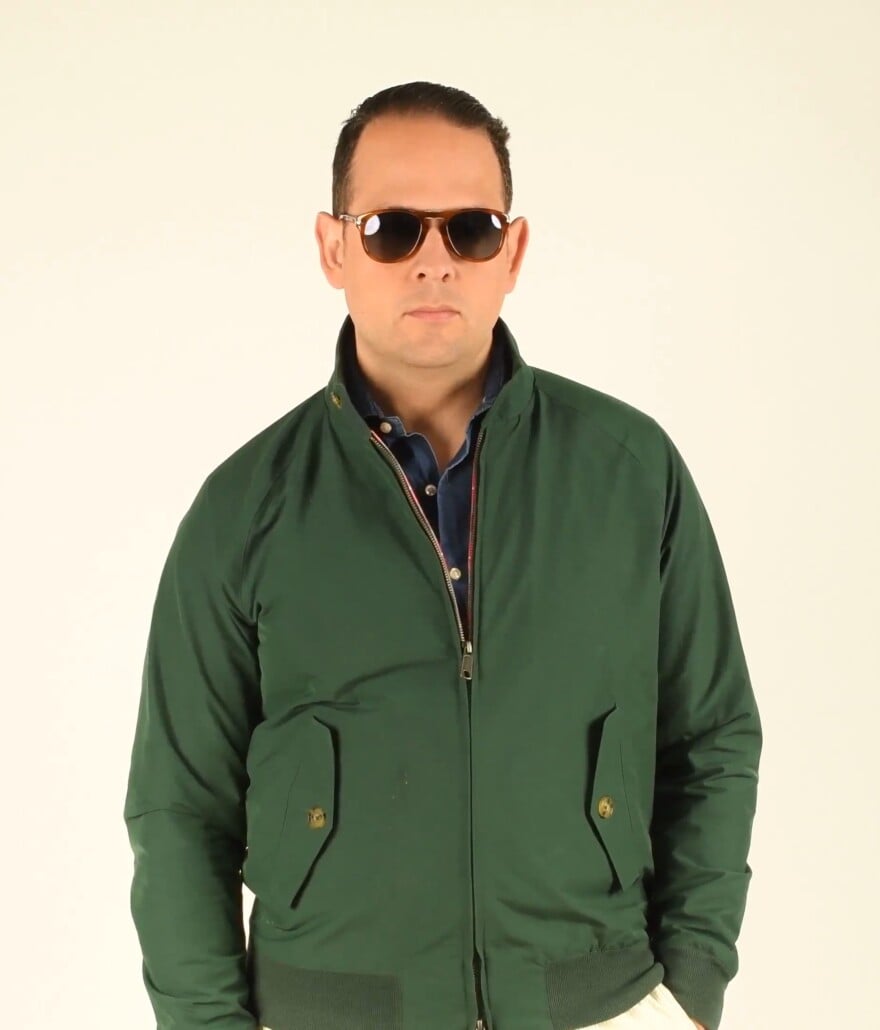
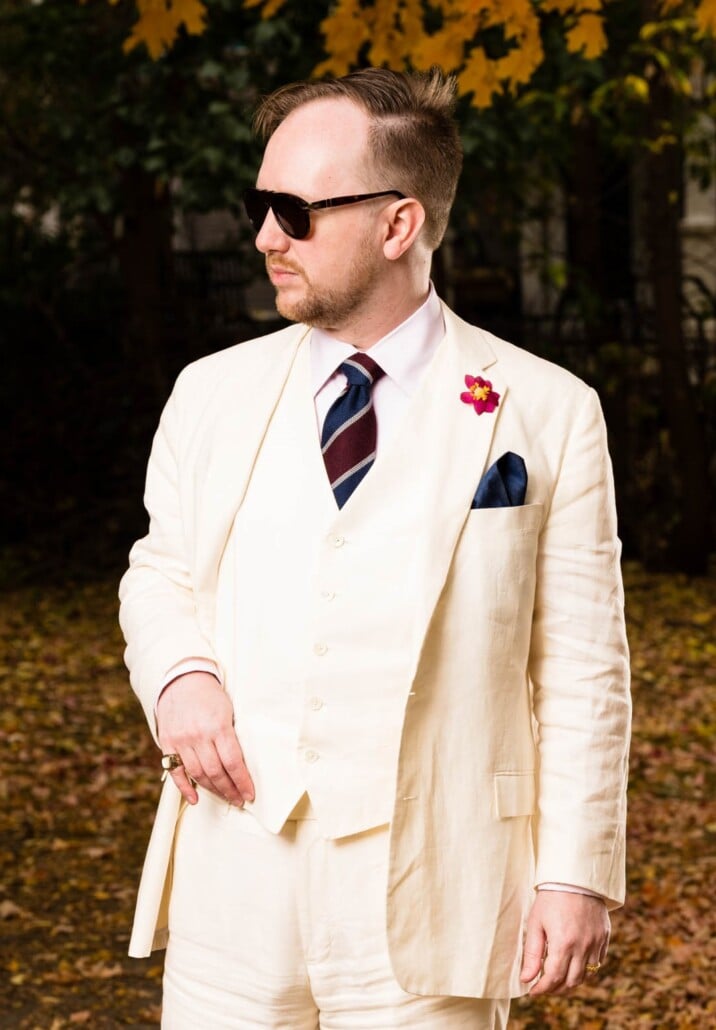
Originally worn by Italian tram operators, Persol sunglasses rose to prominence in the 1960s and 1970s after being worn by major film celebrities like Steve McQueen and Marcello Mastroianni. Regularly retailing for between $200 and $400, the most common Persol sunglasses are the Model 714, which can fold into quarters, and the similarly styled but non-quarter-foldable Model 649.
Are Persol sunglasses worth it? Find out!
Sunglasses Prices
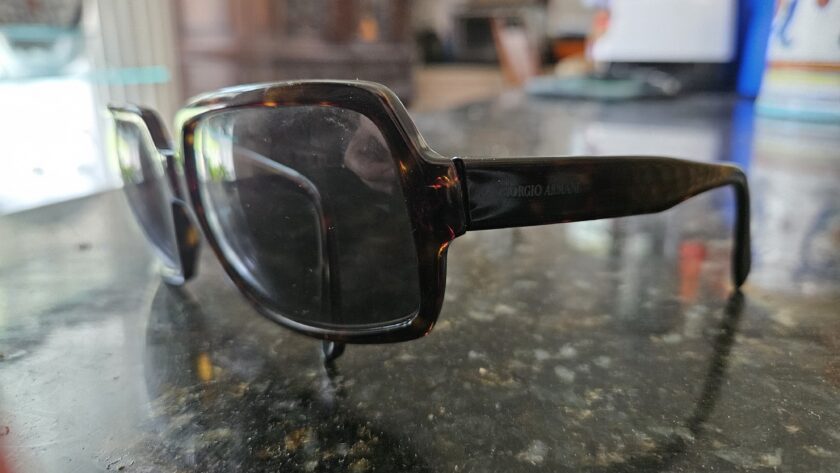
To help as you set a budget and do your initial research into sunglasses, please find below a table detailing common sunglasses in menswear and their approximate costs.
| Brand Name | Price (2023) |
|---|---|
| Sunski Yuba | $58 |
| Warby Parker Hannon | +$95 |
| Carrera Champion | $125 |
| Ray-Ban Clubmaster | +$164 |
| Ray-Ban Aviator | +$165 |
| Panto Paris | +$189 |
| Oakley Frogskins | $190 |
| American Optical Original Pilot | $200 |
| Persol Model 649 | +$279 |
| Vuarnet Legend 06 Originals | +$285 |
| Randolph Engineering Aviator | $319 |
| Persol Model 714 | +$335 |
| Moscot Lemtosh | $340 |
| Oliver Goldsmith The 1930’s | +$420 |
| Oliver Peoples Cary Grant | $542 |
| Jacques Marie Mage Enzo | $795 |
| Masahiro Maruyama 00029 No. 2 | $970 |
| Santos de Cartier | +€970 |
| Maison Bonnet (Made-to-Measure) | +€1300 |
| Jacques Marie Mage Cody | $1795 |
| Maison Bonnet (Made-to-Measure) | +€1800 |
How to Care for Your Sunglasses
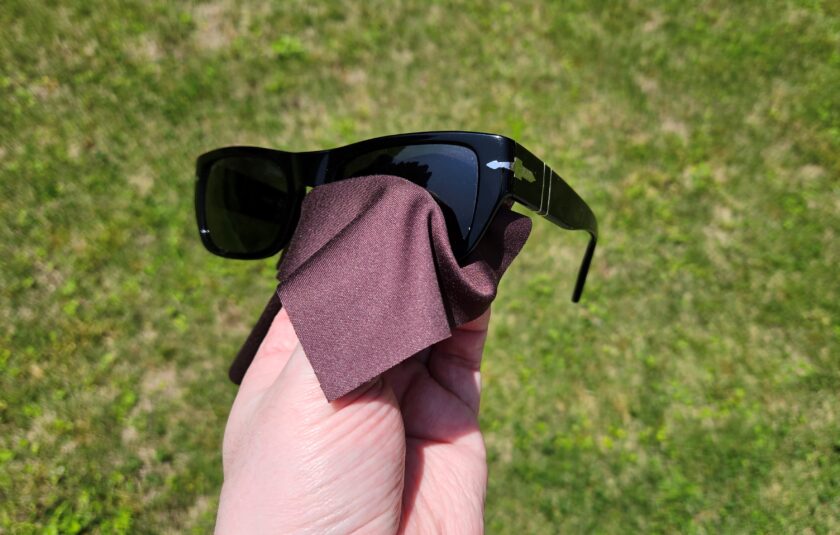
Proper care will ensure that your sunglasses last for as long as possible while looking as good as possible.
- Clean your sunglasses with a microfiber cloth. Avoid cleaning off your sunglasses with whatever fabric is handy, or even with your shirt or trousers. The material may leave tiny scratches or transfer grime that could soil the lenses or tiny particles that could scratch them.
- Use a lens-cleaning solution. While blowing onto your lenses may mist them over, vapor from your breath is not the ideal cleaning liquid. Instead, to remove fingerprints, oil, or other stains, employ a solution specially formulated for sunglasses – it will safely lift away residue without harming the films on the lenses.
- Store your sunglasses properly. When not wearing your sunglasses, always try to store them in their proper case. It is safer and more secure than looping them into your shirt front or belt, and it is easier to keep clean from dust and grime, which can accumulate in your pockets.
- Tighten the arm screws when necessary. If the arms of the sunglasses become wobbly or loose, tighten the screws that connect the arms to the body of the frame. You may need a special screwdriver for this, and if the screws are not accessible, consider asking a local optician to do it for you.
The Do’s and Don’ts of Sunglasses
Don't Look Directly Into the Sun
No matter how high its UV protection rating, no pair of conventional sunglasses was designed to allow you to look at the sun safely. Therefore, do not do it: in addition to being terrible for your eyes, it will also burn through the UV protective film on your sunglasses more quickly.

Don’t Wear Your Sunglasses at Night
Unless you suffer from a medical issue like blindness or extreme light sensitivity, there is no reason for you to be wearing your sunglasses at night: it looks affected and distracting. Even if Corey Hart did write a song about doing this, it still is not congruent with Classic Style.
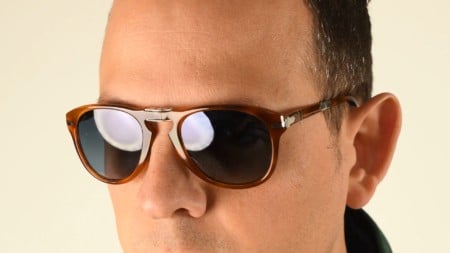
Take Your Sunglasses Off When Indoors
Following the same logic as the above piece of advice, unless they are worn as a matter of medical necessity, do not wear sunglasses indoors unless you find yourself seated directly in front of a beam of light. Wearing sunglasses indoors for dramatic effect often appears overly theatrical and, frankly, a little silly.
![Avoid 1 A pair of Oakleys is not fitting for classic menswear [Image Credit: Kids Racing]](https://www.gentlemansgazette.com/wp-content/uploads/2022/08/avoid-1-450x252.jpg)
Avoid Excessively Bold Sunglasses
Unless they are being worn on sporting occasions, excessively bold sunglasses, like wrap-around styles or chunky vibrantly-colored sunglasses, or novelty sunglasses, like stunner shades, are not typical of the decorum and formality of Classic Style, and should usually be avoided.
Keep Formality in Mind
Sunglasses, like all clothing, have a formality. Endeavor to suit your sunglasses to the formality of the occasion and the formality of the rest of your outfit. Unless absolutely necessitated by climatic conditions, sunglasses should also not be worn with formal attire like morning wear, Black Tie, or White Tie.

Invest in Sunglasses That Fit Your Face
No matter what the brand or how good the deal is, if sunglasses aren’t a good fit for your face, don’t buy them. Also, bear in mind that most faces are not symmetrical, whereas most sunglasses are. So go to an optician, and have your shades adjusted so they fit you well.
Conclusion
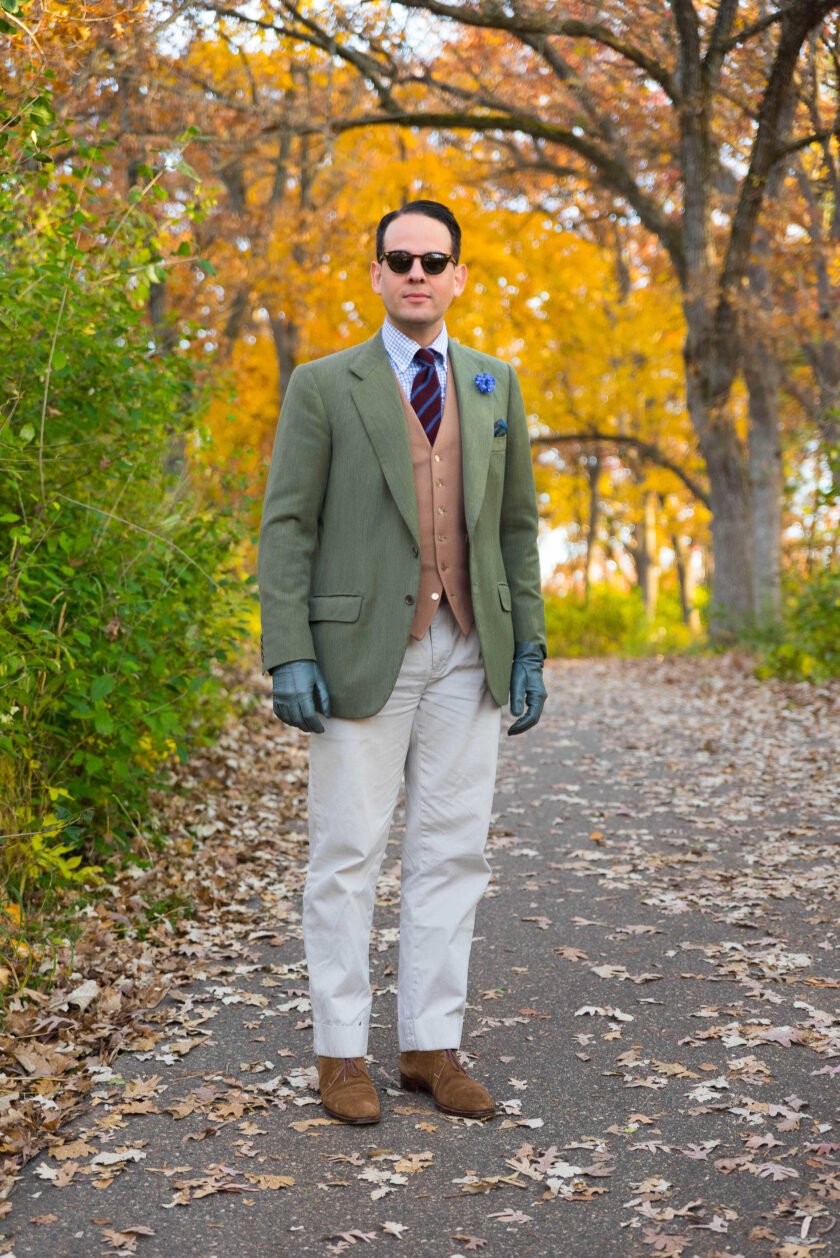
Now that you know everything that there is to know about sunglasses, we hope that you feel as cool as Steve McQueen, as dapper as Alain Delon, and as adventurous as Tom Cruise every time you rock your favorite shades. No matter how brightly the sun might be shining, you’ll be ready to face it with eyes wide open and a smile on your face.
Let us know in the comments: what is your favorite pair of sunglasses?
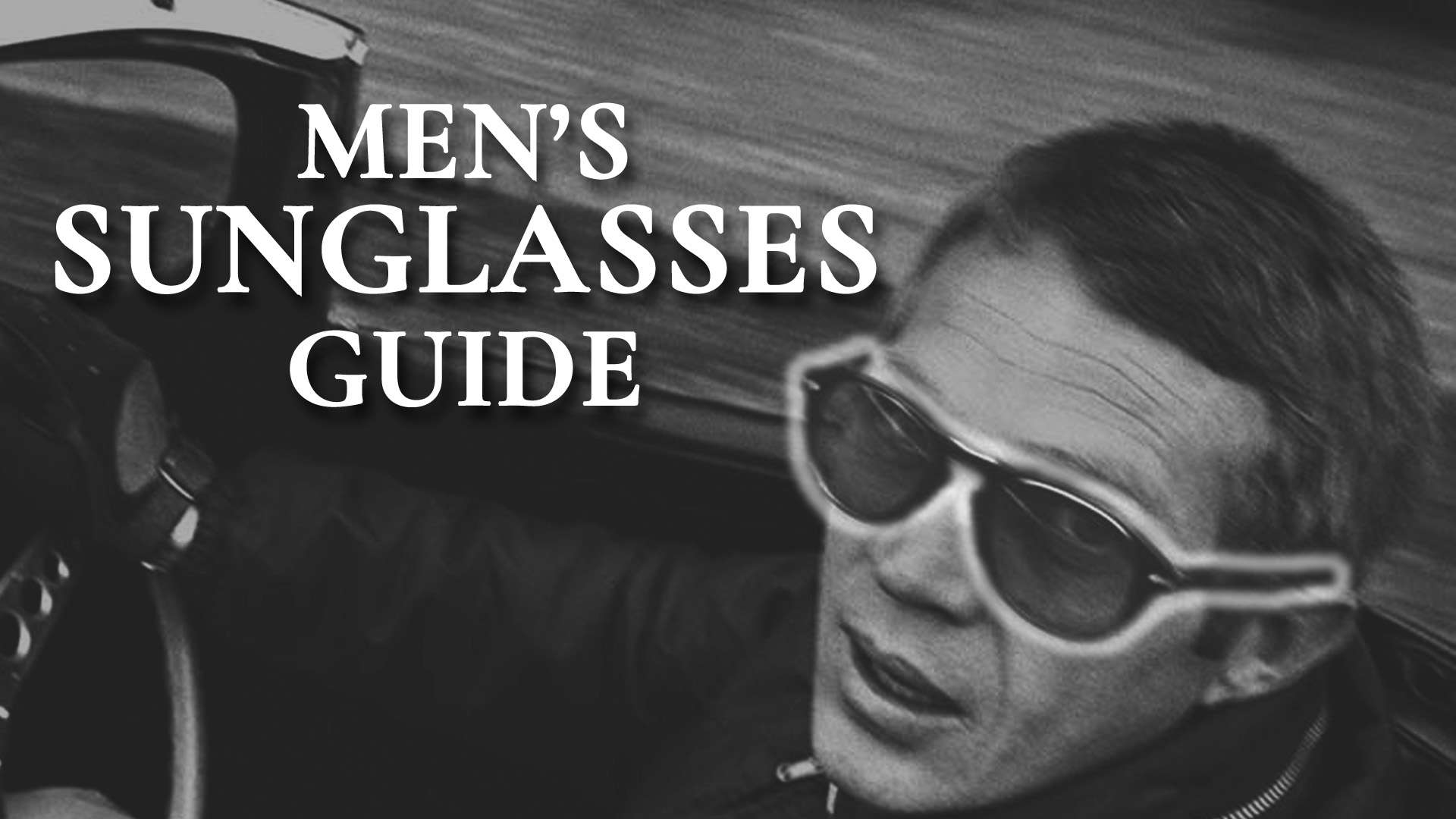


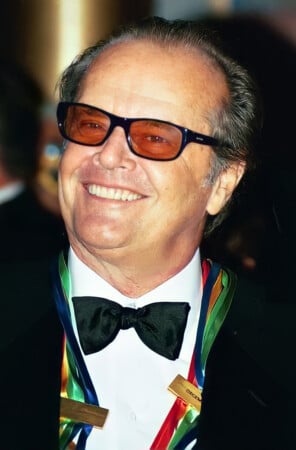
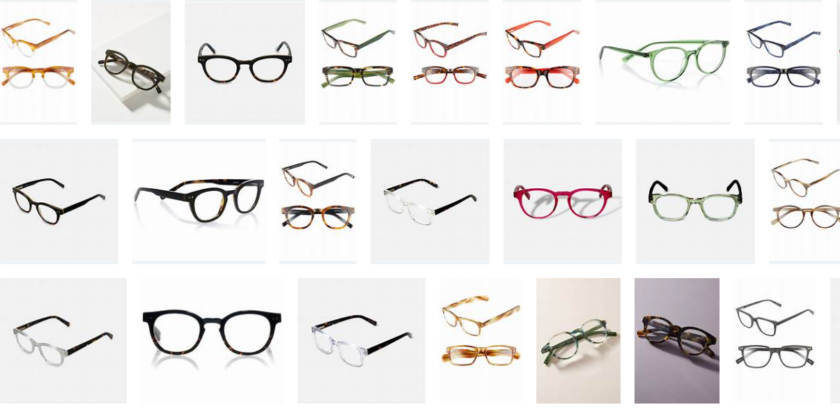

Very informative!!! Thanks!!!!
I stopped reading at the word “Irregardless”
One of the things a gentleman learns is the gift of forgiveness. It is the greatest gift available to mankind and is totally cost free. As soon as I become perfect though, I am going after those who make mistakes. :)
V/r
Paul Curtis
If you have a 54″ chest and a36″ waist, “Dog the bounty hunter” is always an appropriate style.
The aviator style is more than just fashion. A properly fitted pair covers your vision including peripheral vision, important to pilots and other professionals that need to see clearly. The thin metal frames don’t interfere with peripheral vision, as well (I can’t wear anything while driving but glasses with thin temple bars; thick frames distract me). I wore RayBan “Large Metal II” changeable grey glasses in all my days flying in the USCG, providing me great protection, unrestricted vision, and (with flexible, around-the-ear temple bars) didn’t get uncomfortable underneath aviation headsets.
Something to mention is a very easy “distortion” test you can do in stores. Putting sunglasses on generally won’t disclose distortion in any but the worst glasses. I’ve found that I can hold the glasses facing the floor, find a straight line in the overhead ceiling (or better, a fluorescent tube light), then pivot and swivel the lens slowly so the straight line passes over every part of the lenses. Fine glasses, the line will move smoothly and not change (bend, bloat, warp). In cheap glasses, you can see the line or light tube deviate somewhere on the lens. I’ve put more than a few expensive, “fashion” sunglasses abruptly back on the shelf after finding defects in the lenses.
I would just be careful if you order online and make sure you check them out.
http://www.visionmonday.com/CMSDocuments/Safety%20&%20Compliance%20of%20Prescription%20Eyewear%20Purchased%20Online%209-2011.pdf
This study suggests many frames and or lenses not being up to standards if ordered online and not through a licensed eyecare professional.
Of course, as an addendum, im sure if you are simply purchasing plano sunglasses its generally not a problem.
I just ordered a new pair of classic Wayfarer-style prescription sunglasses from Zenni Optical. Frames are plastic and acetate and may choices of coatings, polarizing, etc. $29 for the frames and with the add ons I ordered, they came to $63 total. Delivery in about two weeks… a lot cheaper than an optician. I have no connection to Zenni other than being a satisfied customer.
The only thing to add concerns polarized lenses. If you’re a pilot you already know NOT to wear polarized lenses while flying. You can’t read the instruments. Try reading your smart phone or your car’s digital instrument panel with polarized lenses. Otherwise they are a great choice! Go with Randolphs!
Oh yeah, irregardless is not a word…..
Quite right. The reason is that many instruments in airplanes (and some instruments and radio faceplates in cars) have polarized lenses. When you look at them wearing polarized sunglasses, the double polarization blocks most or all of what is behind the lens of the instrument or faceplate. Also, polarized lenses in sunglasses tend to be made of some type of plastic. Glass lenses, which are not polarized, are much more scratch-resistant, an important factor for glasses worn on the beach and in other outdoor settings.
As one of the assholes who has long worn sunglasses at night due to a hypersensitivity to light due to a military mishap, I nevertheless enjoyed your article which was comprehensive and informative as are all your digital missives. Bravo!
Sorry about that, there was a miscommunication with the editor and the word should have been removed to begin with, sorry.
Cops wearing mirrored glass’ make me nut’s….
My pet peeve is great looking sunglasses that have a pronounced ear cut and a short “temple”; the only people who could possibly wear them probably wear a Size 3 hat at the most.
I have a fairly strong prescription for my eyesight and I’ve found that it limits the style of lenses I can get. Most exotic shapes can’t be done, and even moderate shaping results in warping of the field of view. It also drives the cost of each pair of sunglasses up, so in the end you can only get one or two and they have to last a long time (so long as your eyesight remains stable). My advice for those with strong prescriptions is to get a good pair that is a simple and lasting design, and to definitely avoid anything trendy.
My regular glasses are Persol 3029Vs and the sunglasses are a new pair of Ray Ban Aviators and a pair of vintage Wayfarers. Pretty much all you need for whatever occasion presents itself. As design icons they are simply timeless and beyond any fashion or style trends and therefor a smart investment.
Dear Sven,
Another fine article with the right mix of history, technology, and explanation. I have two pairs of sunglasses; Maui Jim’s prescription wraparound lenses and a pair of Bausch and Lomb’s. I used to wear the Bausch and Lomb’s when I was flying and wore the Maui Jim’s when sailing. These days I wear prescription lenses that are double coated and appear to be sunglasses. They are prescribed due to age related Macular Degeneration. Then, when I am outdoors I must wear a second pair of even darker glasses over the first. Candidly, it is sometimes embarrassing to wear what appear to be sunglasses when I am indoors but the choice is that or probably blindness if I am not careful.
The point of my comments is to ask that others please not make assumptions about the purpose for wearing dark glasses in what would normally be considered an inappropriate place to do so or when wearing formal wear. For some, it is not a choice.
Best regards,
Paul Curtis
I think you may have gotten the Persol 649 and 714 mixed up, although I am not entirely sure. The 714 is foldable while the 649 is not, Steve McQueen was known to have favored and worn the 714. Personally I like the 649 better…
You’re right, I fixed it and thanks for pointing it out.
Yesterday I was an asshole, today at least I shouln’t wear sunglasses at night. I use corrective glasses and sometimes I dare to leave the house without taking my regular pair of glasses with me.
Oliver, as mentioned in another comment – it was a mistake in the editing process, sorry.
A lotof spammers use this method very abusively and end up getting thewebsite penalized and sometimes even banned.
This is a method, which is geared to attract local consumers
by using specific keywords and phrases throughout
the entire site. One company that has a handle on SEO and all of its ever-changing
trends is The Aussie SEO.
My observation may be as obscure to you as yours is to me unless I explain that in Australia the hokey-cokey is known as the hokey-pokey
Beware of the cheap drugstore glasses! I bought a pair in a pinch once and they shattered when I had them in my pocket and bumped into a desk.
I worked for several years with US and NATO military aviators. Most of them wore or at least had a pair of Randolph Engineering grey glass sunglasses. Some preferred aviators, other the more square NATO lenses, but all used the straight bayonet ear pieces to fit inside a flight helmet. Among their advantages is their resistance to scratching and clarity in all weather conditions. They often wore grey polycarbonate sunglasses ashore or on ground duty – I think Smith and Oakley were very common. Polycarbonate lenses offer a degree of ballistic safety and are highly shatter-resistant, but are less scratch-resistant than glass. Mirror glasses have the coolness factor for some wearers, but excessive use can lead to excess burning and, according to some, skin cancer on the nose.
Sven, you’ve done it again. Another very fine and useful article!
Corey Hart wears his sunglasses at night so he can keep track of the visions in his eyes. (Haha I made a joke.) In all seriousness though this is good advice.
Men in suits wearing sports wrap around sunglasses. Do they not own mirrors.
Hello Raphael,
I noticed you mentioned many lense colors except for blue. Is it not as functional or desirable as the others?
As a new reader I had thought that your recent outburst of foul language was an isolated incident but it would appear from earlier comments that foul language is the norm. To give you the benefit of the doubt, you may only have chosen an unwise article to recycle and perhaps a change of subject would be for the best. I have read your masterly treatise on Polo and trust that you can help me with a lapse of memory – I am ashamed to admit that, having been captain of the school team in my last year at Roedean, I have forgotten the rules of British Bulldog. I would enjoy an editorial on British Bulldog similar to that on Polo and believe that your other readers would too.
British Bulldog! That takes me back. Did you practice as shirts and skins like we did so that everyone knew who was on which side? As to my own suggestion, dancing is considered a gentlemanly accomplishment in England, and, or so I believe, the whole of Europe, and some instruction on the steps for a simple waltz for example would be appreciated. I do not claim that it is often that a young lady extends an invitation to me but whenever one does, I feel embarrassed having to decline and sit it out until the hokey-cokey. In case Mr Schneider is unfamiliar with the hokey-cokey, someone calls out the steps which makes it all very easy.
Nice article. Great overview of the history of sunglasses. I wouldn’t agree though that brown lenses are usually better than gray ones. I had a customer who told me his sunnies with brown lenses just didn’t feel right. I sent him a new pair the same model but with gray lenses and his was very satisfied. So I’d say you should try different kinds and colors of lenses and then decide what is better for you.
I completely satisfied with the content of this post. But, still can’t figure out where that word is written, people are talking about. Please elaborate someone!